The Impact of Information Systems on Business Organizations
VerifiedAdded on 2020/04/15
|28
|4611
|91
Report
AI Summary
This report examines the impact of information systems (IS) on organizations, specifically using Hilton Hotels as a case study. It begins with an executive summary and introduction, outlining the benefits of IS implementation in today's technological landscape. The report then provides background information on Hilton Hotels, including its business model and market position, followed by an analysis using Porter's Five Forces. The core of the report focuses on the methodology, including the context and objectives for IS implementation, the implementation process, and a timeline of activities and expenditures. Evaluation techniques are discussed, including the DeLone and McLean IS Success Model, Stakeholder Theory, and a CRM Evaluation Model. The report then applies these models to evaluate the benefits of using an IS system, including intangible and tangible benefits for various stakeholders. It also presents a cost-benefit analysis and discusses limitations of the IS system. The report concludes with recommendations for improvement and a comprehensive list of references, along with appendices. The analysis emphasizes how IS enhances customer satisfaction, streamlines processes, and contributes to overall organizational success. The report highlights how Hilton Hotels leverages IS to gain a competitive advantage.
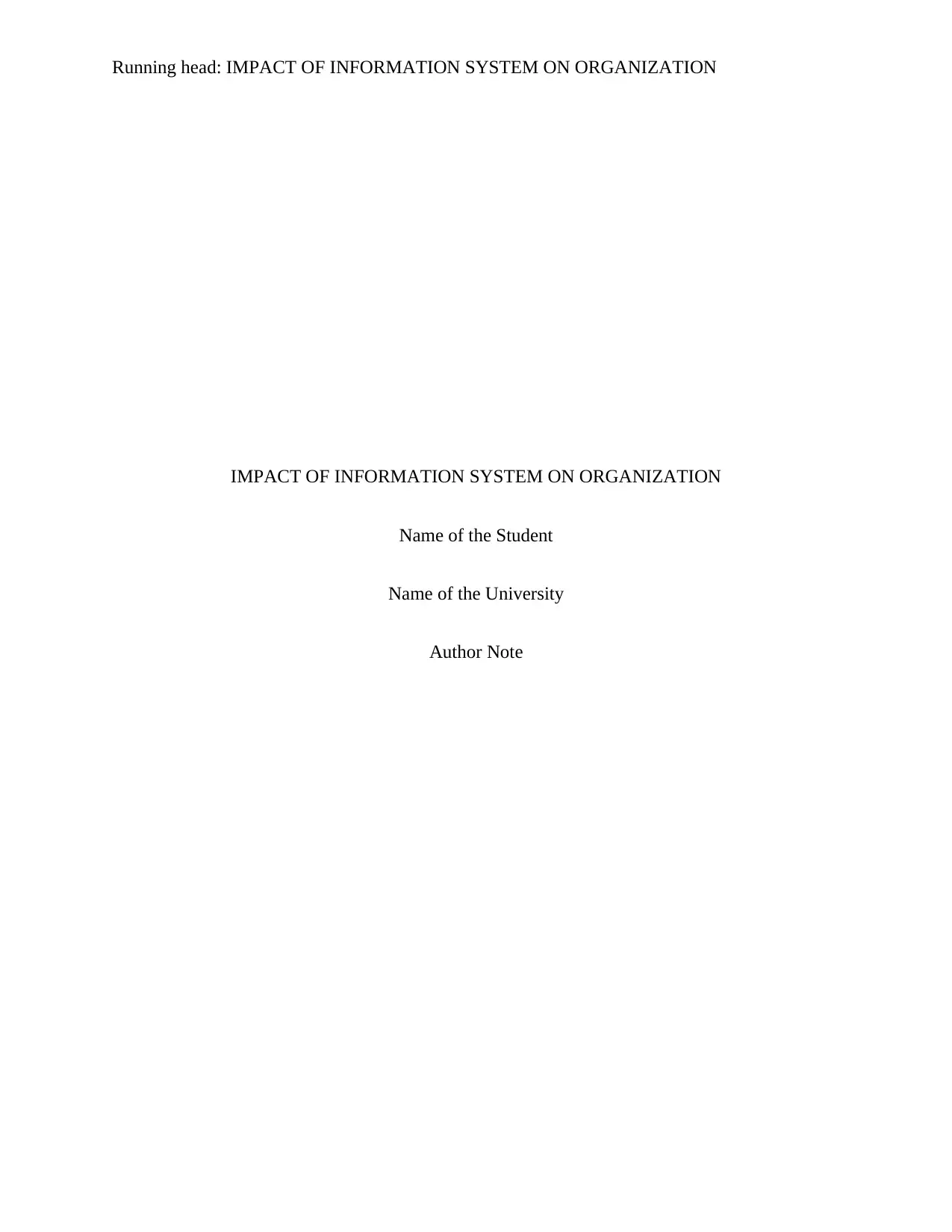
Running head: IMPACT OF INFORMATION SYSTEM ON ORGANIZATION
IMPACT OF INFORMATION SYSTEM ON ORGANIZATION
Name of the Student
Name of the University
Author Note
IMPACT OF INFORMATION SYSTEM ON ORGANIZATION
Name of the Student
Name of the University
Author Note
Secure Best Marks with AI Grader
Need help grading? Try our AI Grader for instant feedback on your assignments.
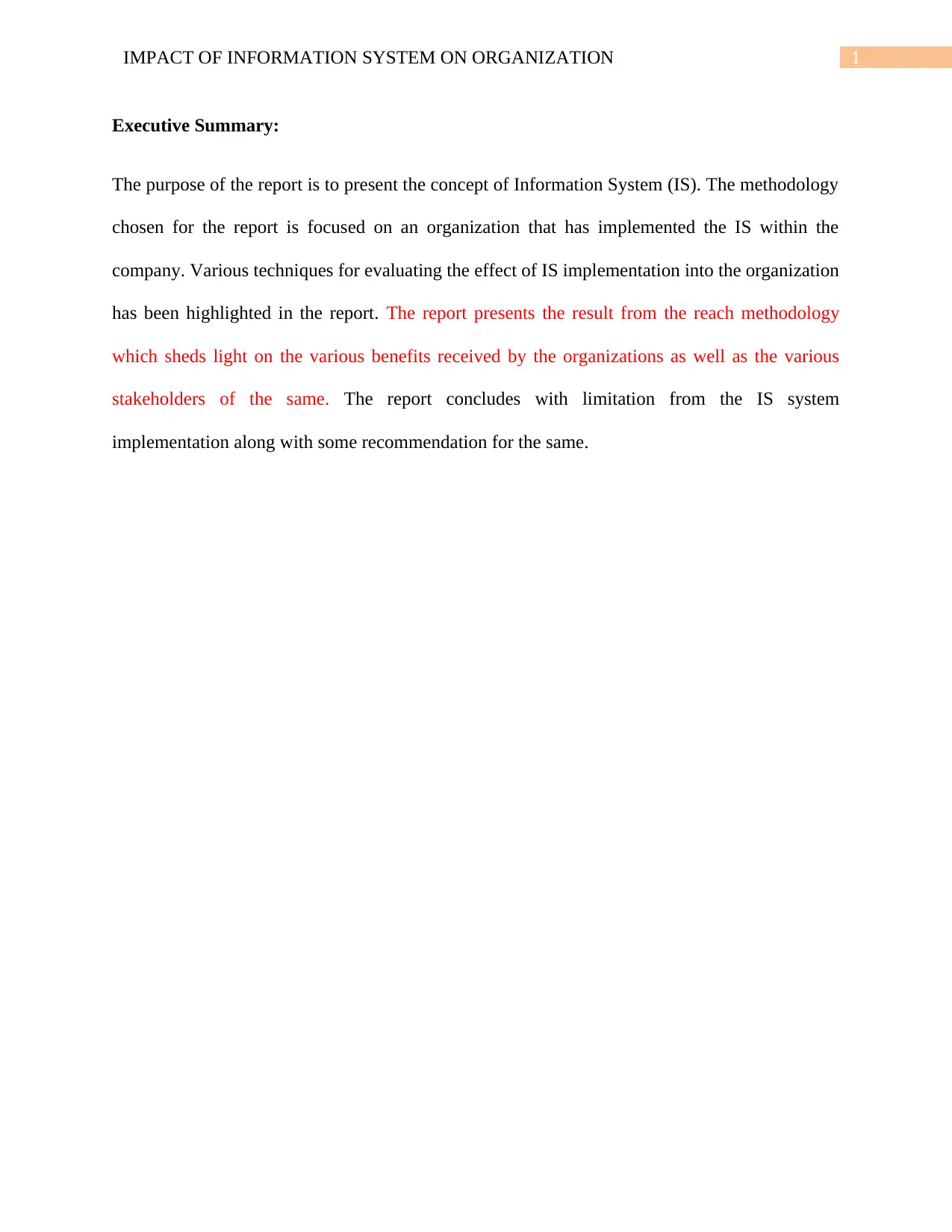
1IMPACT OF INFORMATION SYSTEM ON ORGANIZATION
Executive Summary:
The purpose of the report is to present the concept of Information System (IS). The methodology
chosen for the report is focused on an organization that has implemented the IS within the
company. Various techniques for evaluating the effect of IS implementation into the organization
has been highlighted in the report. The report presents the result from the reach methodology
which sheds light on the various benefits received by the organizations as well as the various
stakeholders of the same. The report concludes with limitation from the IS system
implementation along with some recommendation for the same.
Executive Summary:
The purpose of the report is to present the concept of Information System (IS). The methodology
chosen for the report is focused on an organization that has implemented the IS within the
company. Various techniques for evaluating the effect of IS implementation into the organization
has been highlighted in the report. The report presents the result from the reach methodology
which sheds light on the various benefits received by the organizations as well as the various
stakeholders of the same. The report concludes with limitation from the IS system
implementation along with some recommendation for the same.
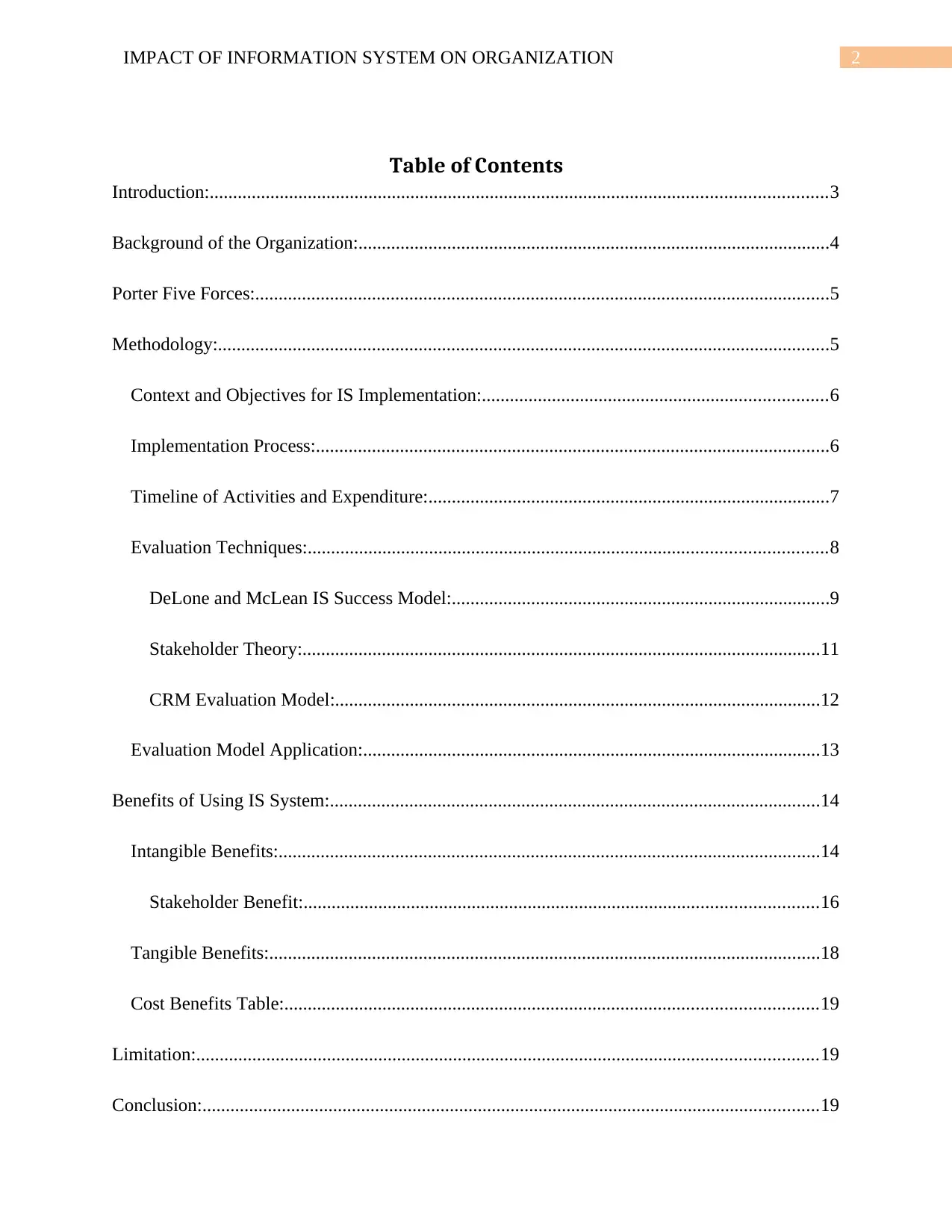
2IMPACT OF INFORMATION SYSTEM ON ORGANIZATION
Table of Contents
Introduction:....................................................................................................................................3
Background of the Organization:.....................................................................................................4
Porter Five Forces:...........................................................................................................................5
Methodology:...................................................................................................................................5
Context and Objectives for IS Implementation:..........................................................................6
Implementation Process:..............................................................................................................6
Timeline of Activities and Expenditure:......................................................................................7
Evaluation Techniques:...............................................................................................................8
DeLone and McLean IS Success Model:.................................................................................9
Stakeholder Theory:...............................................................................................................11
CRM Evaluation Model:........................................................................................................12
Evaluation Model Application:..................................................................................................13
Benefits of Using IS System:.........................................................................................................14
Intangible Benefits:....................................................................................................................14
Stakeholder Benefit:..............................................................................................................16
Tangible Benefits:......................................................................................................................18
Cost Benefits Table:..................................................................................................................19
Limitation:.....................................................................................................................................19
Conclusion:....................................................................................................................................19
Table of Contents
Introduction:....................................................................................................................................3
Background of the Organization:.....................................................................................................4
Porter Five Forces:...........................................................................................................................5
Methodology:...................................................................................................................................5
Context and Objectives for IS Implementation:..........................................................................6
Implementation Process:..............................................................................................................6
Timeline of Activities and Expenditure:......................................................................................7
Evaluation Techniques:...............................................................................................................8
DeLone and McLean IS Success Model:.................................................................................9
Stakeholder Theory:...............................................................................................................11
CRM Evaluation Model:........................................................................................................12
Evaluation Model Application:..................................................................................................13
Benefits of Using IS System:.........................................................................................................14
Intangible Benefits:....................................................................................................................14
Stakeholder Benefit:..............................................................................................................16
Tangible Benefits:......................................................................................................................18
Cost Benefits Table:..................................................................................................................19
Limitation:.....................................................................................................................................19
Conclusion:....................................................................................................................................19
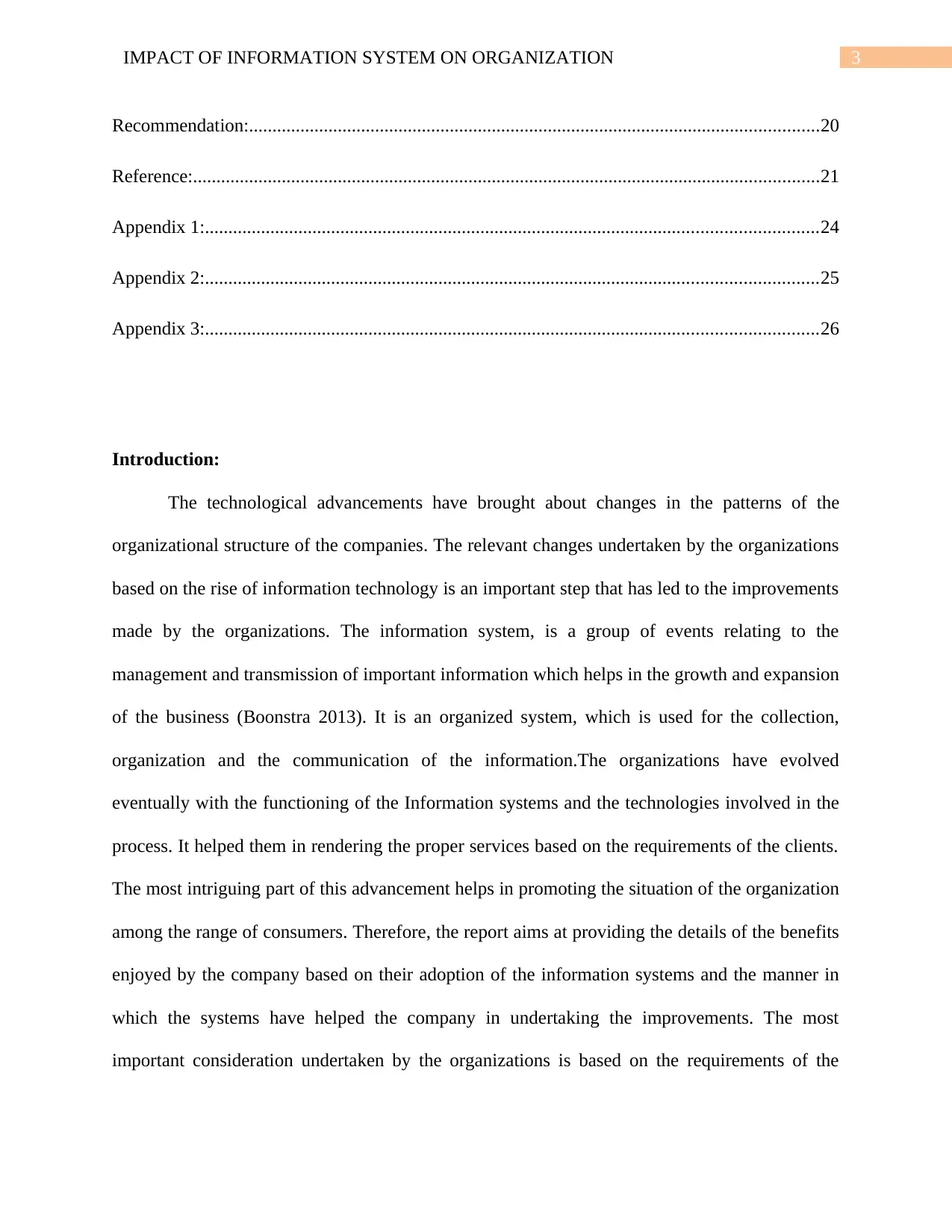
3IMPACT OF INFORMATION SYSTEM ON ORGANIZATION
Recommendation:..........................................................................................................................20
Reference:......................................................................................................................................21
Appendix 1:...................................................................................................................................24
Appendix 2:...................................................................................................................................25
Appendix 3:...................................................................................................................................26
Introduction:
The technological advancements have brought about changes in the patterns of the
organizational structure of the companies. The relevant changes undertaken by the organizations
based on the rise of information technology is an important step that has led to the improvements
made by the organizations. The information system, is a group of events relating to the
management and transmission of important information which helps in the growth and expansion
of the business (Boonstra 2013). It is an organized system, which is used for the collection,
organization and the communication of the information.The organizations have evolved
eventually with the functioning of the Information systems and the technologies involved in the
process. It helped them in rendering the proper services based on the requirements of the clients.
The most intriguing part of this advancement helps in promoting the situation of the organization
among the range of consumers. Therefore, the report aims at providing the details of the benefits
enjoyed by the company based on their adoption of the information systems and the manner in
which the systems have helped the company in undertaking the improvements. The most
important consideration undertaken by the organizations is based on the requirements of the
Recommendation:..........................................................................................................................20
Reference:......................................................................................................................................21
Appendix 1:...................................................................................................................................24
Appendix 2:...................................................................................................................................25
Appendix 3:...................................................................................................................................26
Introduction:
The technological advancements have brought about changes in the patterns of the
organizational structure of the companies. The relevant changes undertaken by the organizations
based on the rise of information technology is an important step that has led to the improvements
made by the organizations. The information system, is a group of events relating to the
management and transmission of important information which helps in the growth and expansion
of the business (Boonstra 2013). It is an organized system, which is used for the collection,
organization and the communication of the information.The organizations have evolved
eventually with the functioning of the Information systems and the technologies involved in the
process. It helped them in rendering the proper services based on the requirements of the clients.
The most intriguing part of this advancement helps in promoting the situation of the organization
among the range of consumers. Therefore, the report aims at providing the details of the benefits
enjoyed by the company based on their adoption of the information systems and the manner in
which the systems have helped the company in undertaking the improvements. The most
important consideration undertaken by the organizations is based on the requirements of the
Secure Best Marks with AI Grader
Need help grading? Try our AI Grader for instant feedback on your assignments.
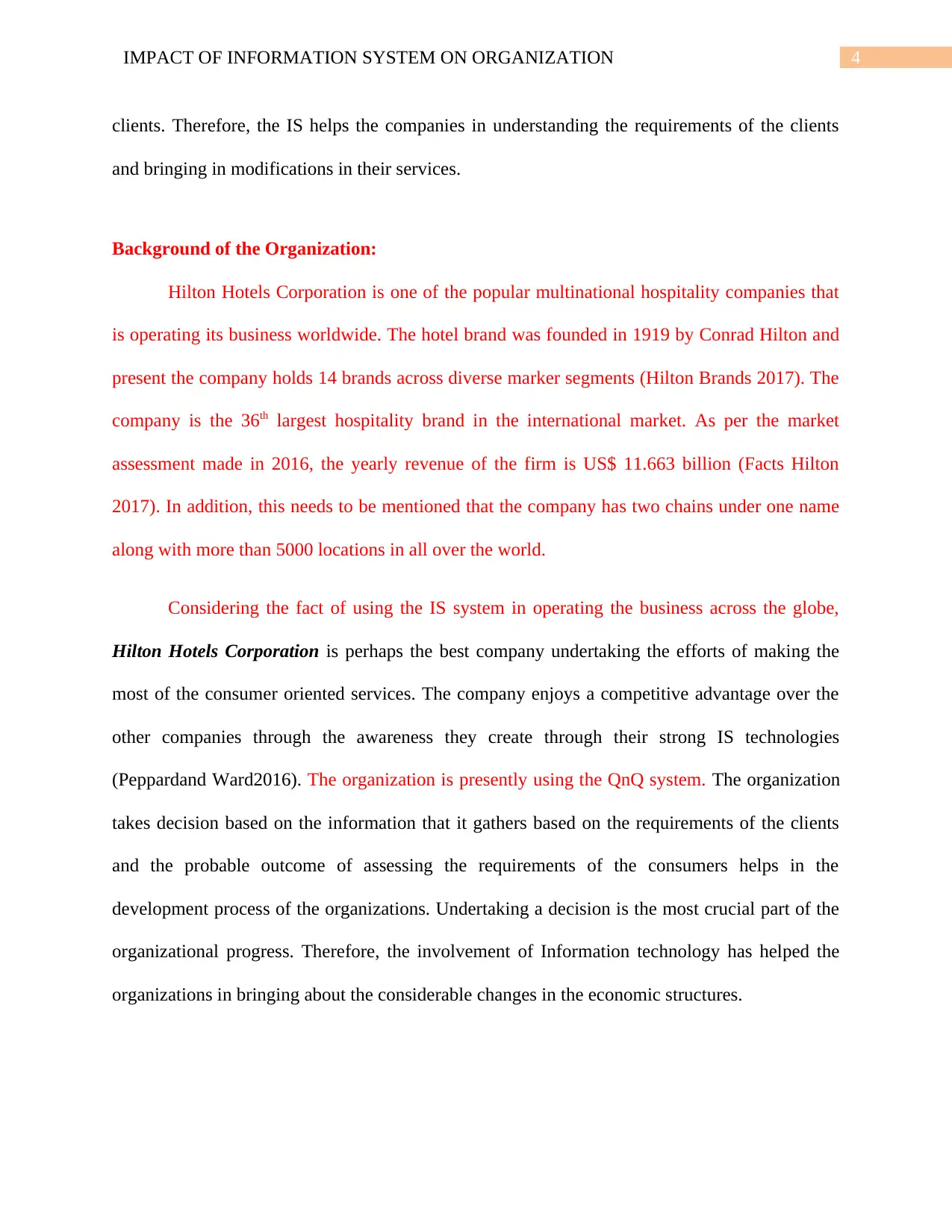
4IMPACT OF INFORMATION SYSTEM ON ORGANIZATION
clients. Therefore, the IS helps the companies in understanding the requirements of the clients
and bringing in modifications in their services.
Background of the Organization:
Hilton Hotels Corporation is one of the popular multinational hospitality companies that
is operating its business worldwide. The hotel brand was founded in 1919 by Conrad Hilton and
present the company holds 14 brands across diverse marker segments (Hilton Brands 2017). The
company is the 36th largest hospitality brand in the international market. As per the market
assessment made in 2016, the yearly revenue of the firm is US$ 11.663 billion (Facts Hilton
2017). In addition, this needs to be mentioned that the company has two chains under one name
along with more than 5000 locations in all over the world.
Considering the fact of using the IS system in operating the business across the globe,
Hilton Hotels Corporation is perhaps the best company undertaking the efforts of making the
most of the consumer oriented services. The company enjoys a competitive advantage over the
other companies through the awareness they create through their strong IS technologies
(Peppardand Ward2016). The organization is presently using the QnQ system. The organization
takes decision based on the information that it gathers based on the requirements of the clients
and the probable outcome of assessing the requirements of the consumers helps in the
development process of the organizations. Undertaking a decision is the most crucial part of the
organizational progress. Therefore, the involvement of Information technology has helped the
organizations in bringing about the considerable changes in the economic structures.
clients. Therefore, the IS helps the companies in understanding the requirements of the clients
and bringing in modifications in their services.
Background of the Organization:
Hilton Hotels Corporation is one of the popular multinational hospitality companies that
is operating its business worldwide. The hotel brand was founded in 1919 by Conrad Hilton and
present the company holds 14 brands across diverse marker segments (Hilton Brands 2017). The
company is the 36th largest hospitality brand in the international market. As per the market
assessment made in 2016, the yearly revenue of the firm is US$ 11.663 billion (Facts Hilton
2017). In addition, this needs to be mentioned that the company has two chains under one name
along with more than 5000 locations in all over the world.
Considering the fact of using the IS system in operating the business across the globe,
Hilton Hotels Corporation is perhaps the best company undertaking the efforts of making the
most of the consumer oriented services. The company enjoys a competitive advantage over the
other companies through the awareness they create through their strong IS technologies
(Peppardand Ward2016). The organization is presently using the QnQ system. The organization
takes decision based on the information that it gathers based on the requirements of the clients
and the probable outcome of assessing the requirements of the consumers helps in the
development process of the organizations. Undertaking a decision is the most crucial part of the
organizational progress. Therefore, the involvement of Information technology has helped the
organizations in bringing about the considerable changes in the economic structures.
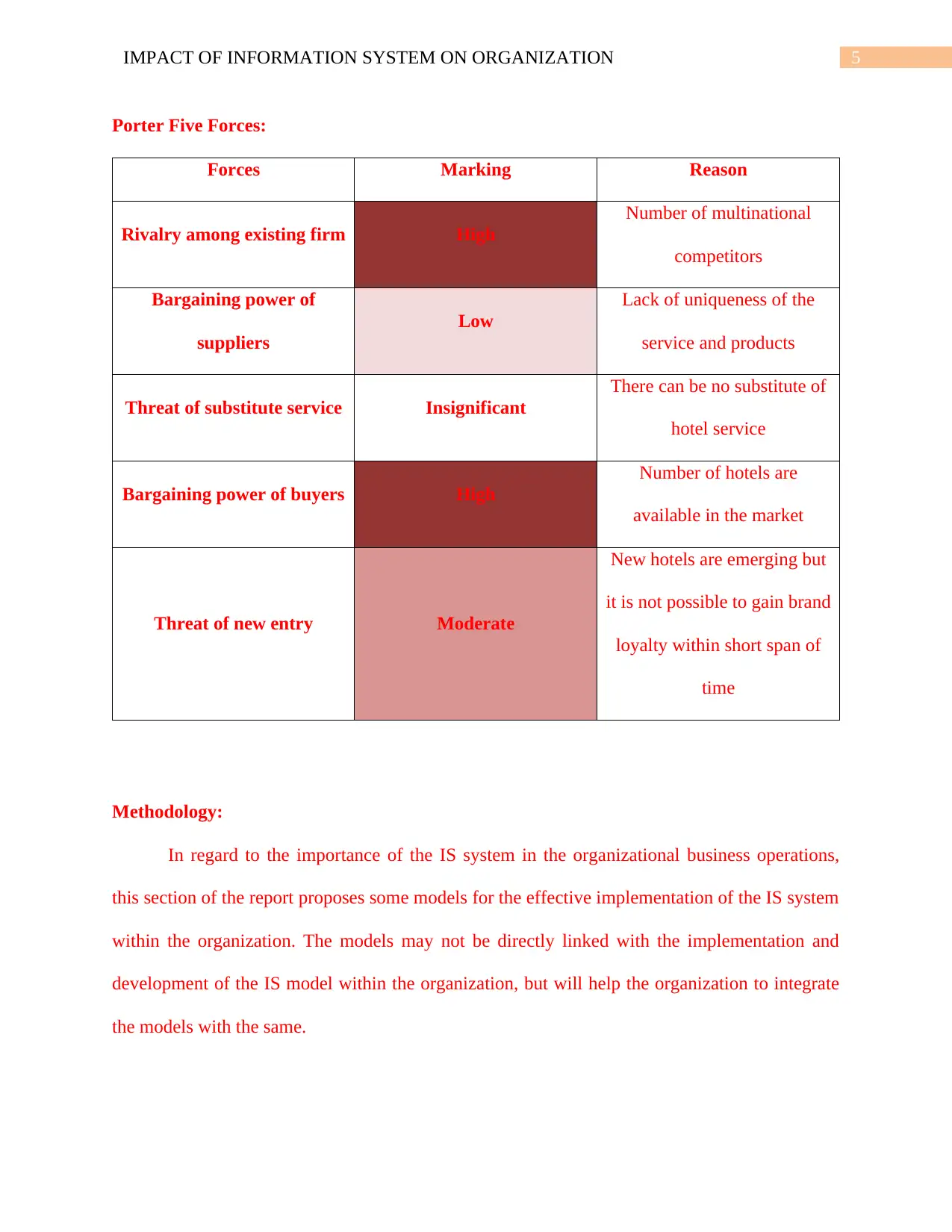
5IMPACT OF INFORMATION SYSTEM ON ORGANIZATION
Porter Five Forces:
Forces Marking Reason
Rivalry among existing firm High
Number of multinational
competitors
Bargaining power of
suppliers
Low
Lack of uniqueness of the
service and products
Threat of substitute service Insignificant
There can be no substitute of
hotel service
Bargaining power of buyers High
Number of hotels are
available in the market
Threat of new entry Moderate
New hotels are emerging but
it is not possible to gain brand
loyalty within short span of
time
Methodology:
In regard to the importance of the IS system in the organizational business operations,
this section of the report proposes some models for the effective implementation of the IS system
within the organization. The models may not be directly linked with the implementation and
development of the IS model within the organization, but will help the organization to integrate
the models with the same.
Porter Five Forces:
Forces Marking Reason
Rivalry among existing firm High
Number of multinational
competitors
Bargaining power of
suppliers
Low
Lack of uniqueness of the
service and products
Threat of substitute service Insignificant
There can be no substitute of
hotel service
Bargaining power of buyers High
Number of hotels are
available in the market
Threat of new entry Moderate
New hotels are emerging but
it is not possible to gain brand
loyalty within short span of
time
Methodology:
In regard to the importance of the IS system in the organizational business operations,
this section of the report proposes some models for the effective implementation of the IS system
within the organization. The models may not be directly linked with the implementation and
development of the IS model within the organization, but will help the organization to integrate
the models with the same.
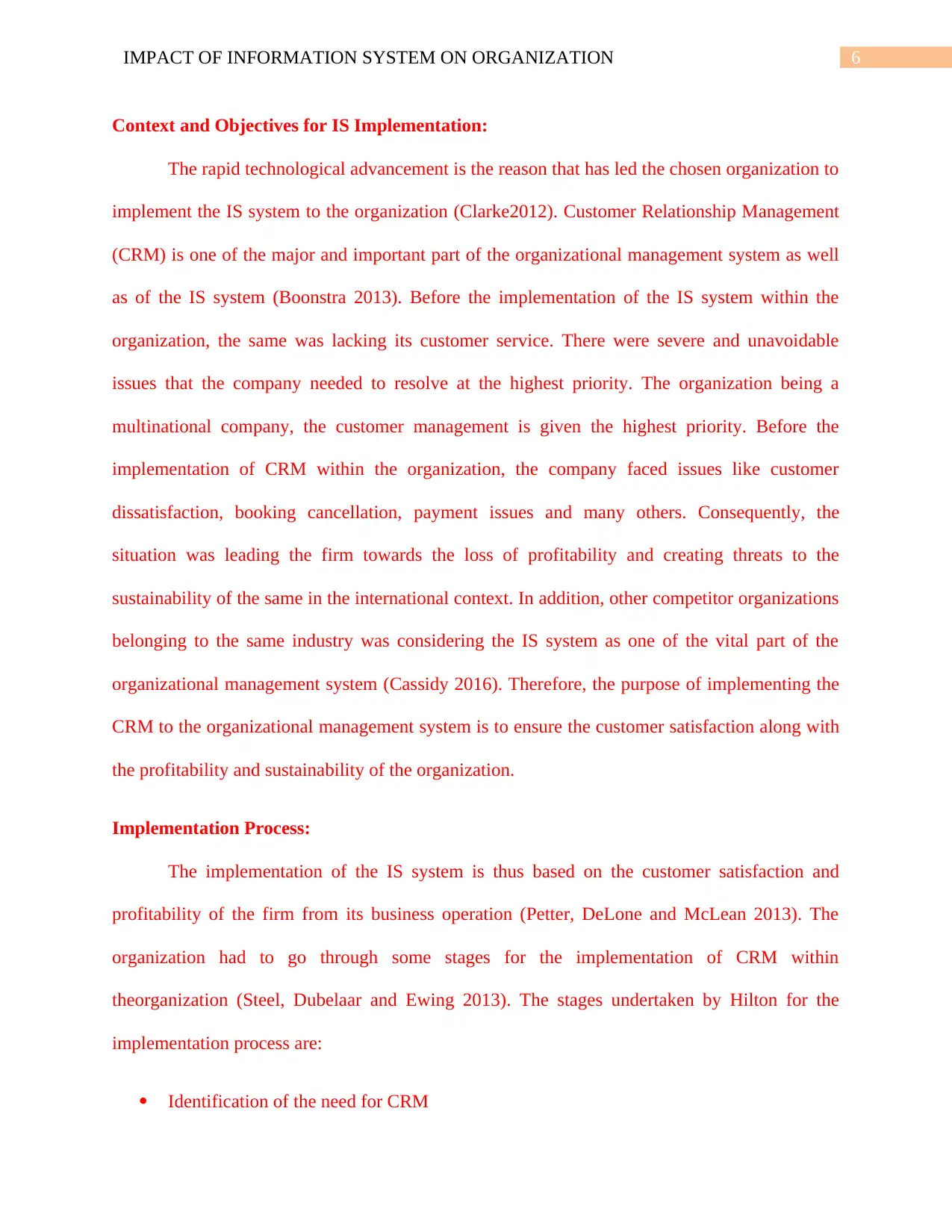
6IMPACT OF INFORMATION SYSTEM ON ORGANIZATION
Context and Objectives for IS Implementation:
The rapid technological advancement is the reason that has led the chosen organization to
implement the IS system to the organization (Clarke2012). Customer Relationship Management
(CRM) is one of the major and important part of the organizational management system as well
as of the IS system (Boonstra 2013). Before the implementation of the IS system within the
organization, the same was lacking its customer service. There were severe and unavoidable
issues that the company needed to resolve at the highest priority. The organization being a
multinational company, the customer management is given the highest priority. Before the
implementation of CRM within the organization, the company faced issues like customer
dissatisfaction, booking cancellation, payment issues and many others. Consequently, the
situation was leading the firm towards the loss of profitability and creating threats to the
sustainability of the same in the international context. In addition, other competitor organizations
belonging to the same industry was considering the IS system as one of the vital part of the
organizational management system (Cassidy 2016). Therefore, the purpose of implementing the
CRM to the organizational management system is to ensure the customer satisfaction along with
the profitability and sustainability of the organization.
Implementation Process:
The implementation of the IS system is thus based on the customer satisfaction and
profitability of the firm from its business operation (Petter, DeLone and McLean 2013). The
organization had to go through some stages for the implementation of CRM within
theorganization (Steel, Dubelaar and Ewing 2013). The stages undertaken by Hilton for the
implementation process are:
Identification of the need for CRM
Context and Objectives for IS Implementation:
The rapid technological advancement is the reason that has led the chosen organization to
implement the IS system to the organization (Clarke2012). Customer Relationship Management
(CRM) is one of the major and important part of the organizational management system as well
as of the IS system (Boonstra 2013). Before the implementation of the IS system within the
organization, the same was lacking its customer service. There were severe and unavoidable
issues that the company needed to resolve at the highest priority. The organization being a
multinational company, the customer management is given the highest priority. Before the
implementation of CRM within the organization, the company faced issues like customer
dissatisfaction, booking cancellation, payment issues and many others. Consequently, the
situation was leading the firm towards the loss of profitability and creating threats to the
sustainability of the same in the international context. In addition, other competitor organizations
belonging to the same industry was considering the IS system as one of the vital part of the
organizational management system (Cassidy 2016). Therefore, the purpose of implementing the
CRM to the organizational management system is to ensure the customer satisfaction along with
the profitability and sustainability of the organization.
Implementation Process:
The implementation of the IS system is thus based on the customer satisfaction and
profitability of the firm from its business operation (Petter, DeLone and McLean 2013). The
organization had to go through some stages for the implementation of CRM within
theorganization (Steel, Dubelaar and Ewing 2013). The stages undertaken by Hilton for the
implementation process are:
Identification of the need for CRM
Paraphrase This Document
Need a fresh take? Get an instant paraphrase of this document with our AI Paraphraser
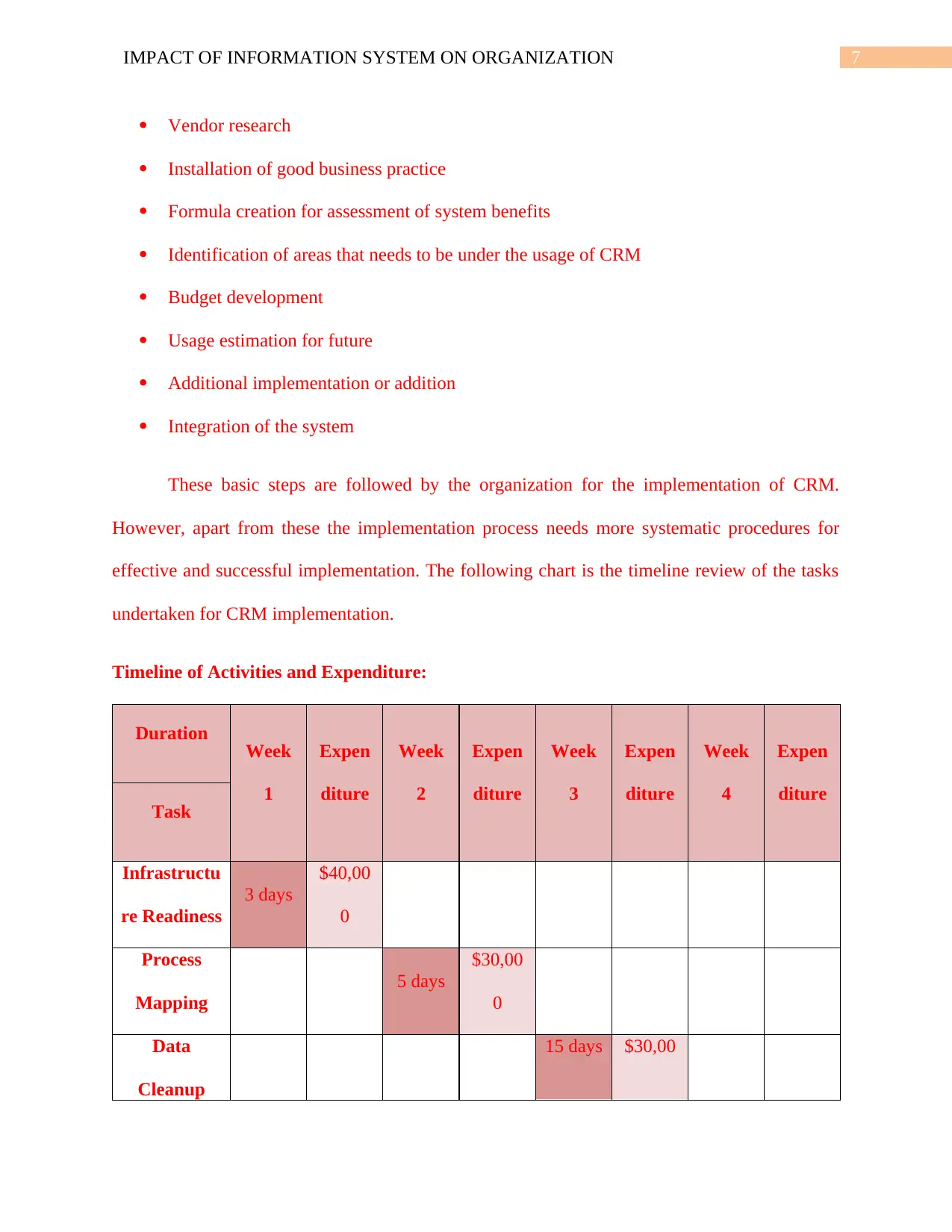
7IMPACT OF INFORMATION SYSTEM ON ORGANIZATION
Vendor research
Installation of good business practice
Formula creation for assessment of system benefits
Identification of areas that needs to be under the usage of CRM
Budget development
Usage estimation for future
Additional implementation or addition
Integration of the system
These basic steps are followed by the organization for the implementation of CRM.
However, apart from these the implementation process needs more systematic procedures for
effective and successful implementation. The following chart is the timeline review of the tasks
undertaken for CRM implementation.
Timeline of Activities and Expenditure:
Duration Week
1
Expen
diture
Week
2
Expen
diture
Week
3
Expen
diture
Week
4
Expen
diture
Task
Infrastructu
re Readiness
3 days
$40,00
0
Process
Mapping
5 days
$30,00
0
Data
Cleanup
15 days $30,00
Vendor research
Installation of good business practice
Formula creation for assessment of system benefits
Identification of areas that needs to be under the usage of CRM
Budget development
Usage estimation for future
Additional implementation or addition
Integration of the system
These basic steps are followed by the organization for the implementation of CRM.
However, apart from these the implementation process needs more systematic procedures for
effective and successful implementation. The following chart is the timeline review of the tasks
undertaken for CRM implementation.
Timeline of Activities and Expenditure:
Duration Week
1
Expen
diture
Week
2
Expen
diture
Week
3
Expen
diture
Week
4
Expen
diture
Task
Infrastructu
re Readiness
3 days
$40,00
0
Process
Mapping
5 days
$30,00
0
Data
Cleanup
15 days $30,00
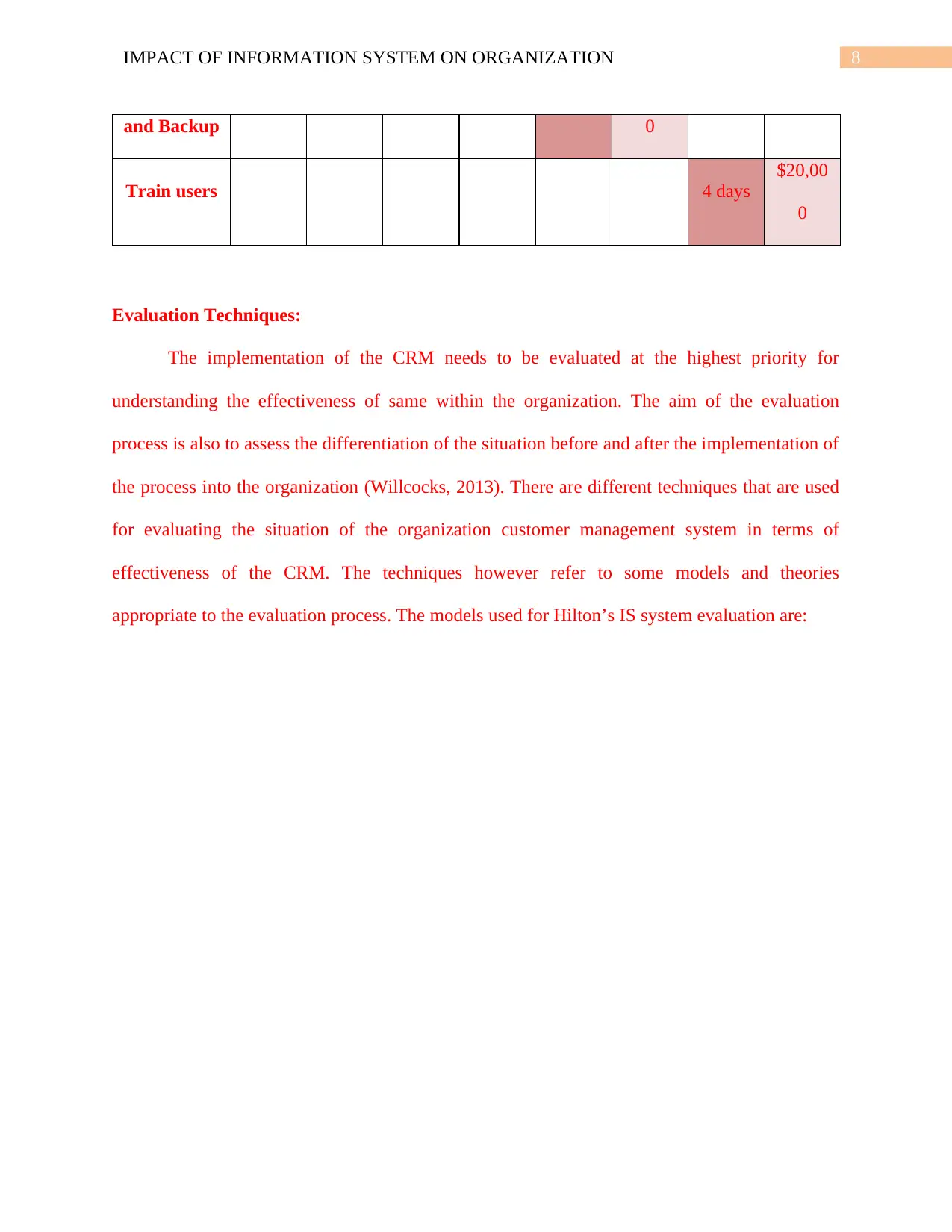
8IMPACT OF INFORMATION SYSTEM ON ORGANIZATION
and Backup 0
Train users 4 days
$20,00
0
Evaluation Techniques:
The implementation of the CRM needs to be evaluated at the highest priority for
understanding the effectiveness of same within the organization. The aim of the evaluation
process is also to assess the differentiation of the situation before and after the implementation of
the process into the organization (Willcocks, 2013). There are different techniques that are used
for evaluating the situation of the organization customer management system in terms of
effectiveness of the CRM. The techniques however refer to some models and theories
appropriate to the evaluation process. The models used for Hilton’s IS system evaluation are:
and Backup 0
Train users 4 days
$20,00
0
Evaluation Techniques:
The implementation of the CRM needs to be evaluated at the highest priority for
understanding the effectiveness of same within the organization. The aim of the evaluation
process is also to assess the differentiation of the situation before and after the implementation of
the process into the organization (Willcocks, 2013). There are different techniques that are used
for evaluating the situation of the organization customer management system in terms of
effectiveness of the CRM. The techniques however refer to some models and theories
appropriate to the evaluation process. The models used for Hilton’s IS system evaluation are:
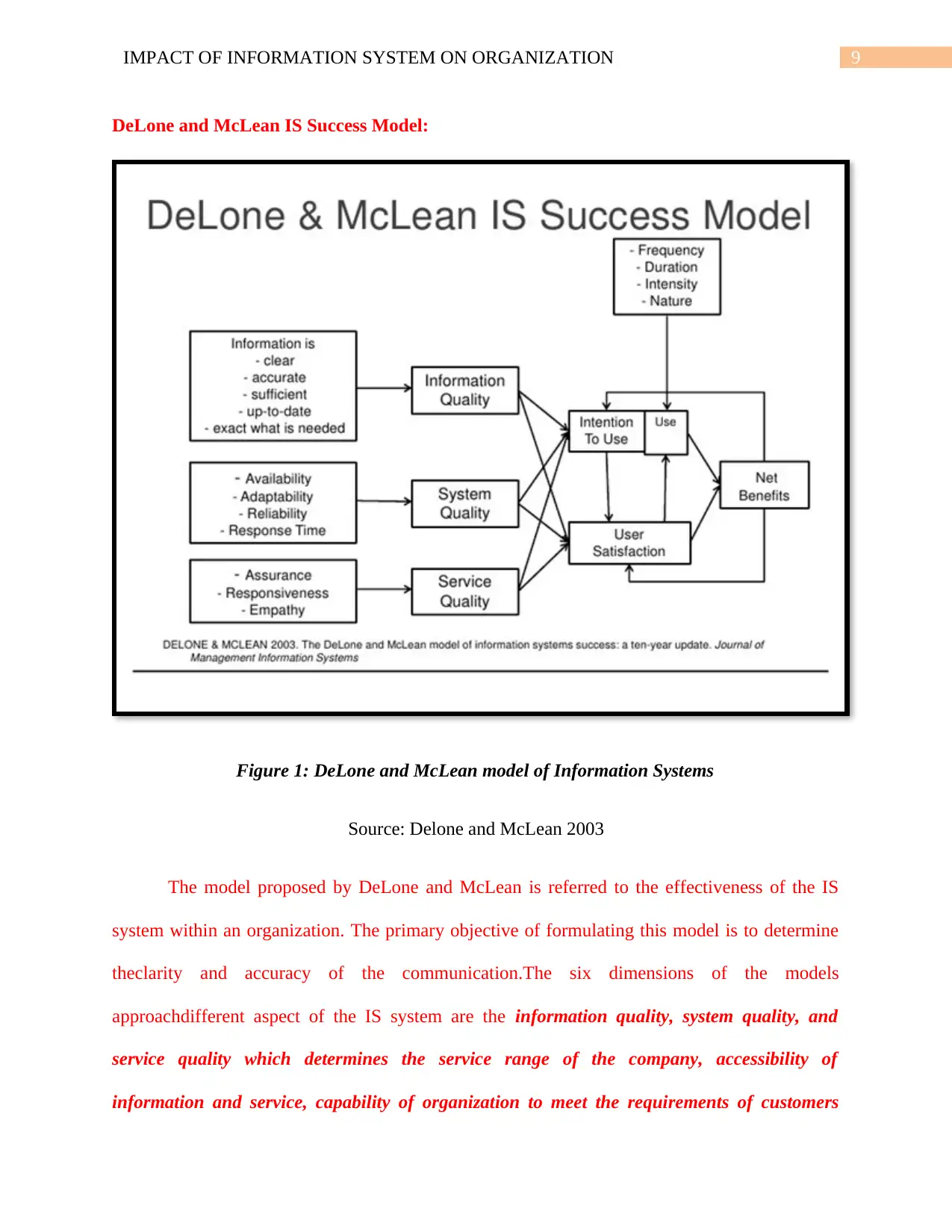
9IMPACT OF INFORMATION SYSTEM ON ORGANIZATION
DeLone and McLean IS Success Model:
Figure 1: DeLone and McLean model of Information Systems
Source: Delone and McLean 2003
The model proposed by DeLone and McLean is referred to the effectiveness of the IS
system within an organization. The primary objective of formulating this model is to determine
theclarity and accuracy of the communication.The six dimensions of the models
approachdifferent aspect of the IS system are the information quality, system quality, and
service quality which determines the service range of the company, accessibility of
information and service, capability of organization to meet the requirements of customers
DeLone and McLean IS Success Model:
Figure 1: DeLone and McLean model of Information Systems
Source: Delone and McLean 2003
The model proposed by DeLone and McLean is referred to the effectiveness of the IS
system within an organization. The primary objective of formulating this model is to determine
theclarity and accuracy of the communication.The six dimensions of the models
approachdifferent aspect of the IS system are the information quality, system quality, and
service quality which determines the service range of the company, accessibility of
information and service, capability of organization to meet the requirements of customers
Secure Best Marks with AI Grader
Need help grading? Try our AI Grader for instant feedback on your assignments.
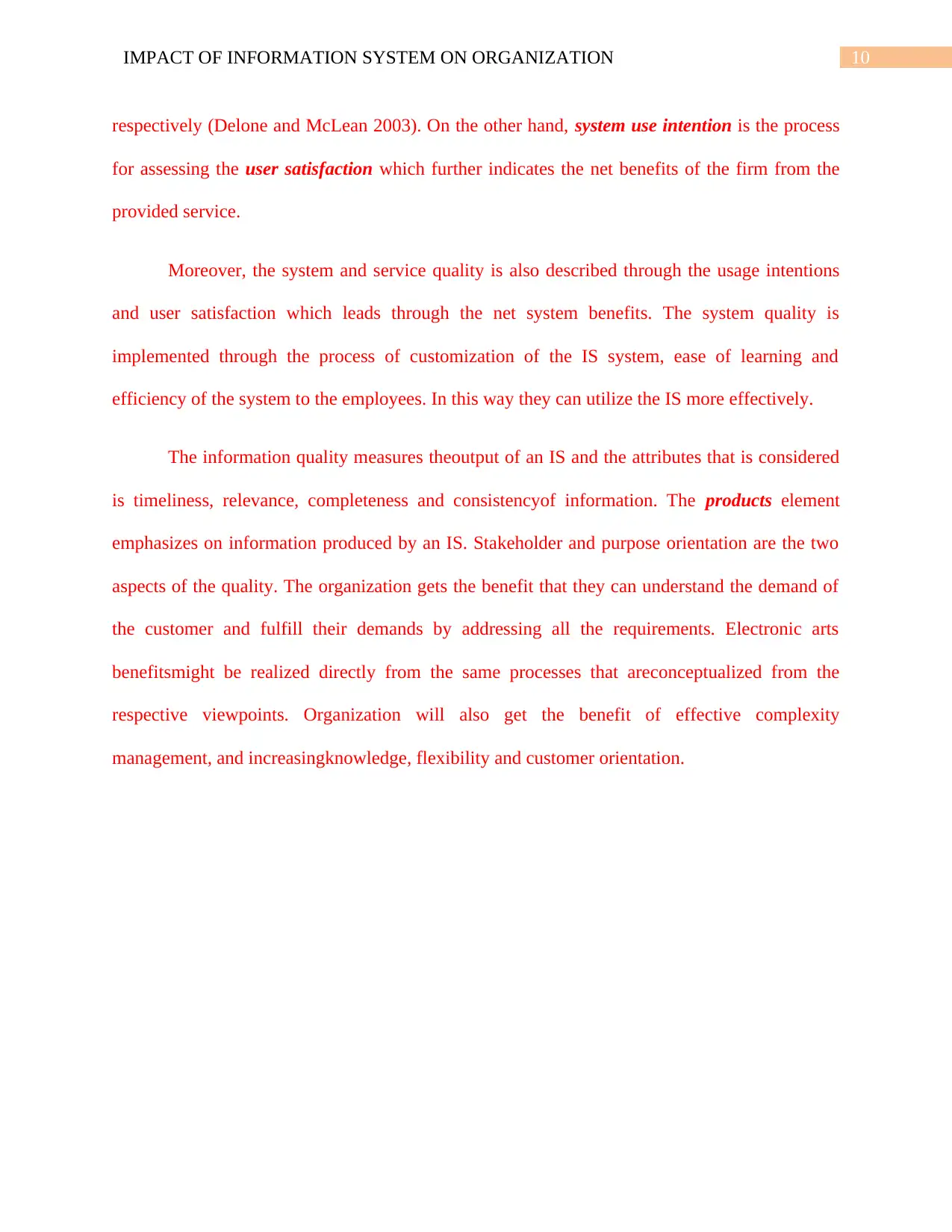
10IMPACT OF INFORMATION SYSTEM ON ORGANIZATION
respectively (Delone and McLean 2003). On the other hand, system use intention is the process
for assessing the user satisfaction which further indicates the net benefits of the firm from the
provided service.
Moreover, the system and service quality is also described through the usage intentions
and user satisfaction which leads through the net system benefits. The system quality is
implemented through the process of customization of the IS system, ease of learning and
efficiency of the system to the employees. In this way they can utilize the IS more effectively.
The information quality measures theoutput of an IS and the attributes that is considered
is timeliness, relevance, completeness and consistencyof information. The products element
emphasizes on information produced by an IS. Stakeholder and purpose orientation are the two
aspects of the quality. The organization gets the benefit that they can understand the demand of
the customer and fulfill their demands by addressing all the requirements. Electronic arts
benefitsmight be realized directly from the same processes that areconceptualized from the
respective viewpoints. Organization will also get the benefit of effective complexity
management, and increasingknowledge, flexibility and customer orientation.
respectively (Delone and McLean 2003). On the other hand, system use intention is the process
for assessing the user satisfaction which further indicates the net benefits of the firm from the
provided service.
Moreover, the system and service quality is also described through the usage intentions
and user satisfaction which leads through the net system benefits. The system quality is
implemented through the process of customization of the IS system, ease of learning and
efficiency of the system to the employees. In this way they can utilize the IS more effectively.
The information quality measures theoutput of an IS and the attributes that is considered
is timeliness, relevance, completeness and consistencyof information. The products element
emphasizes on information produced by an IS. Stakeholder and purpose orientation are the two
aspects of the quality. The organization gets the benefit that they can understand the demand of
the customer and fulfill their demands by addressing all the requirements. Electronic arts
benefitsmight be realized directly from the same processes that areconceptualized from the
respective viewpoints. Organization will also get the benefit of effective complexity
management, and increasingknowledge, flexibility and customer orientation.
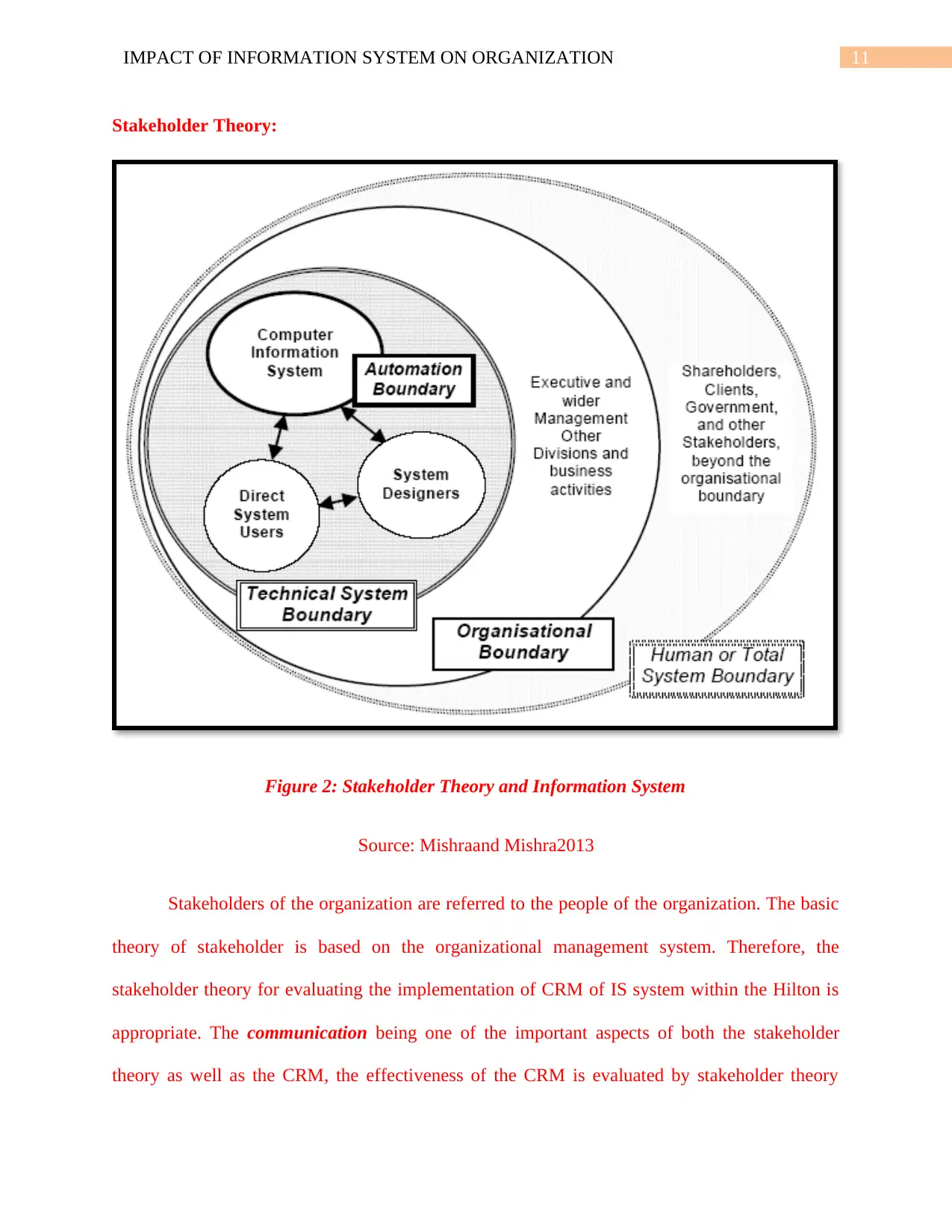
11IMPACT OF INFORMATION SYSTEM ON ORGANIZATION
Stakeholder Theory:
Figure 2: Stakeholder Theory and Information System
Source: Mishraand Mishra2013
Stakeholders of the organization are referred to the people of the organization. The basic
theory of stakeholder is based on the organizational management system. Therefore, the
stakeholder theory for evaluating the implementation of CRM of IS system within the Hilton is
appropriate. The communication being one of the important aspects of both the stakeholder
theory as well as the CRM, the effectiveness of the CRM is evaluated by stakeholder theory
Stakeholder Theory:
Figure 2: Stakeholder Theory and Information System
Source: Mishraand Mishra2013
Stakeholders of the organization are referred to the people of the organization. The basic
theory of stakeholder is based on the organizational management system. Therefore, the
stakeholder theory for evaluating the implementation of CRM of IS system within the Hilton is
appropriate. The communication being one of the important aspects of both the stakeholder
theory as well as the CRM, the effectiveness of the CRM is evaluated by stakeholder theory
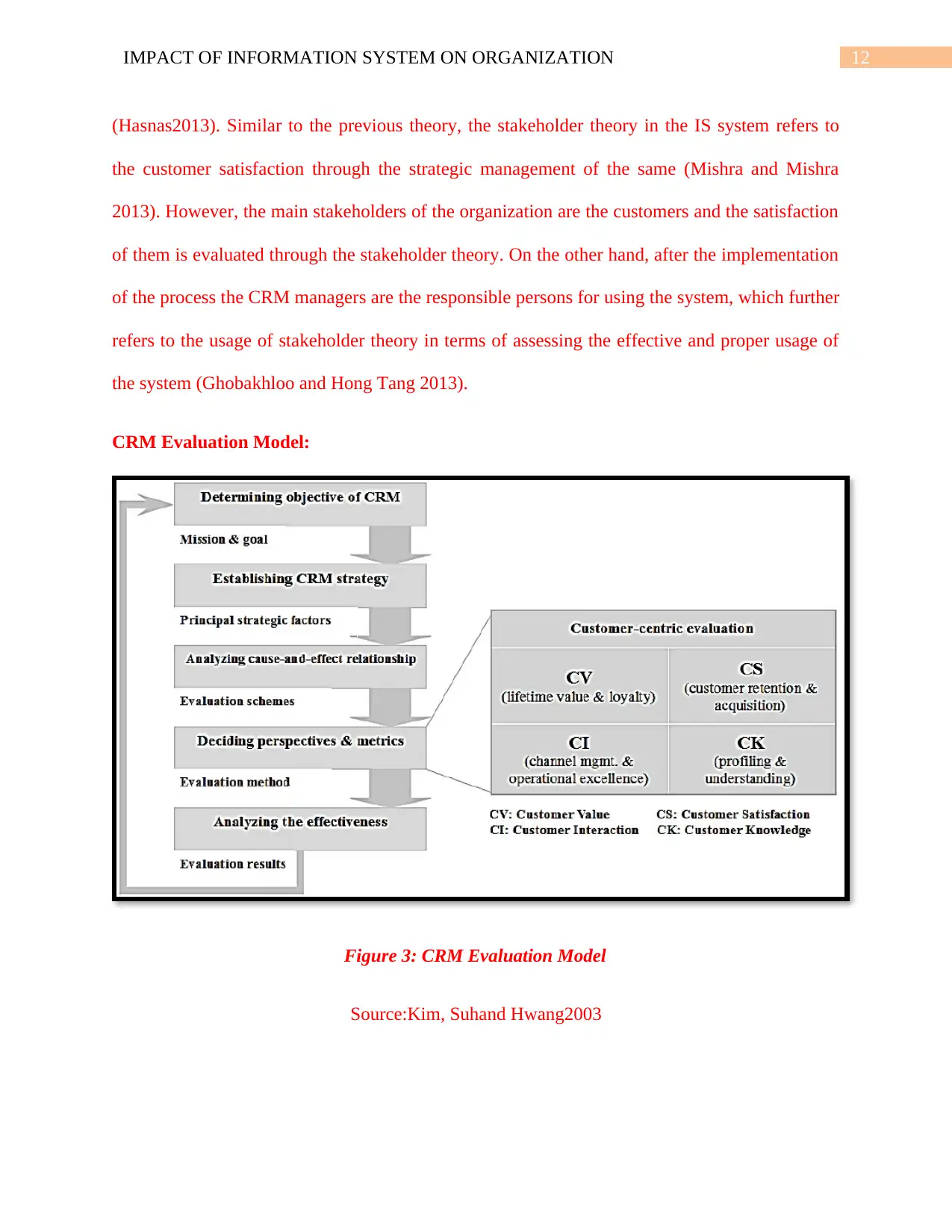
12IMPACT OF INFORMATION SYSTEM ON ORGANIZATION
(Hasnas2013). Similar to the previous theory, the stakeholder theory in the IS system refers to
the customer satisfaction through the strategic management of the same (Mishra and Mishra
2013). However, the main stakeholders of the organization are the customers and the satisfaction
of them is evaluated through the stakeholder theory. On the other hand, after the implementation
of the process the CRM managers are the responsible persons for using the system, which further
refers to the usage of stakeholder theory in terms of assessing the effective and proper usage of
the system (Ghobakhloo and Hong Tang 2013).
CRM Evaluation Model:
Figure 3: CRM Evaluation Model
Source:Kim, Suhand Hwang2003
(Hasnas2013). Similar to the previous theory, the stakeholder theory in the IS system refers to
the customer satisfaction through the strategic management of the same (Mishra and Mishra
2013). However, the main stakeholders of the organization are the customers and the satisfaction
of them is evaluated through the stakeholder theory. On the other hand, after the implementation
of the process the CRM managers are the responsible persons for using the system, which further
refers to the usage of stakeholder theory in terms of assessing the effective and proper usage of
the system (Ghobakhloo and Hong Tang 2013).
CRM Evaluation Model:
Figure 3: CRM Evaluation Model
Source:Kim, Suhand Hwang2003
Paraphrase This Document
Need a fresh take? Get an instant paraphrase of this document with our AI Paraphraser
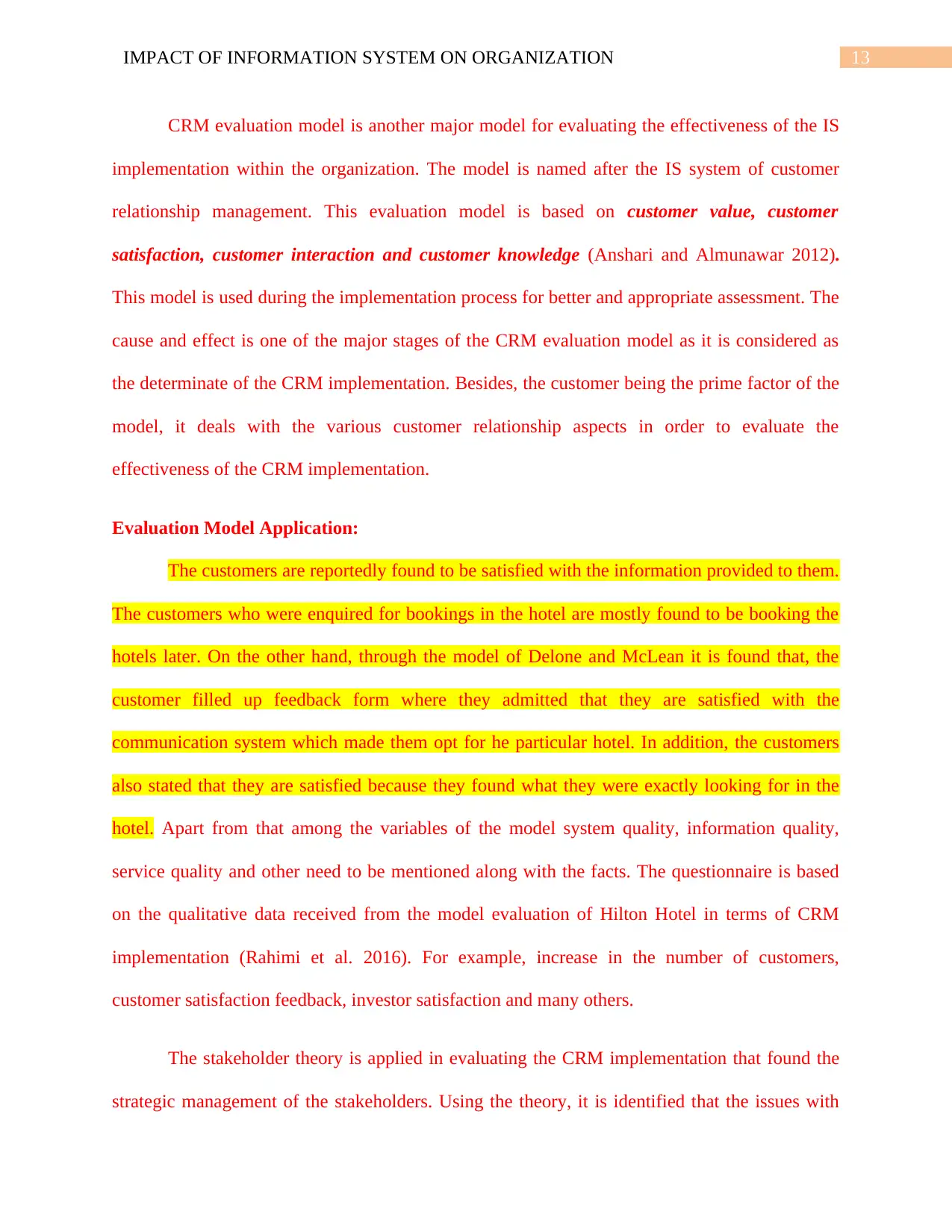
13IMPACT OF INFORMATION SYSTEM ON ORGANIZATION
CRM evaluation model is another major model for evaluating the effectiveness of the IS
implementation within the organization. The model is named after the IS system of customer
relationship management. This evaluation model is based on customer value, customer
satisfaction, customer interaction and customer knowledge (Anshari and Almunawar 2012).
This model is used during the implementation process for better and appropriate assessment. The
cause and effect is one of the major stages of the CRM evaluation model as it is considered as
the determinate of the CRM implementation. Besides, the customer being the prime factor of the
model, it deals with the various customer relationship aspects in order to evaluate the
effectiveness of the CRM implementation.
Evaluation Model Application:
The customers are reportedly found to be satisfied with the information provided to them.
The customers who were enquired for bookings in the hotel are mostly found to be booking the
hotels later. On the other hand, through the model of Delone and McLean it is found that, the
customer filled up feedback form where they admitted that they are satisfied with the
communication system which made them opt for he particular hotel. In addition, the customers
also stated that they are satisfied because they found what they were exactly looking for in the
hotel. Apart from that among the variables of the model system quality, information quality,
service quality and other need to be mentioned along with the facts. The questionnaire is based
on the qualitative data received from the model evaluation of Hilton Hotel in terms of CRM
implementation (Rahimi et al. 2016). For example, increase in the number of customers,
customer satisfaction feedback, investor satisfaction and many others.
The stakeholder theory is applied in evaluating the CRM implementation that found the
strategic management of the stakeholders. Using the theory, it is identified that the issues with
CRM evaluation model is another major model for evaluating the effectiveness of the IS
implementation within the organization. The model is named after the IS system of customer
relationship management. This evaluation model is based on customer value, customer
satisfaction, customer interaction and customer knowledge (Anshari and Almunawar 2012).
This model is used during the implementation process for better and appropriate assessment. The
cause and effect is one of the major stages of the CRM evaluation model as it is considered as
the determinate of the CRM implementation. Besides, the customer being the prime factor of the
model, it deals with the various customer relationship aspects in order to evaluate the
effectiveness of the CRM implementation.
Evaluation Model Application:
The customers are reportedly found to be satisfied with the information provided to them.
The customers who were enquired for bookings in the hotel are mostly found to be booking the
hotels later. On the other hand, through the model of Delone and McLean it is found that, the
customer filled up feedback form where they admitted that they are satisfied with the
communication system which made them opt for he particular hotel. In addition, the customers
also stated that they are satisfied because they found what they were exactly looking for in the
hotel. Apart from that among the variables of the model system quality, information quality,
service quality and other need to be mentioned along with the facts. The questionnaire is based
on the qualitative data received from the model evaluation of Hilton Hotel in terms of CRM
implementation (Rahimi et al. 2016). For example, increase in the number of customers,
customer satisfaction feedback, investor satisfaction and many others.
The stakeholder theory is applied in evaluating the CRM implementation that found the
strategic management of the stakeholders. Using the theory, it is identified that the issues with
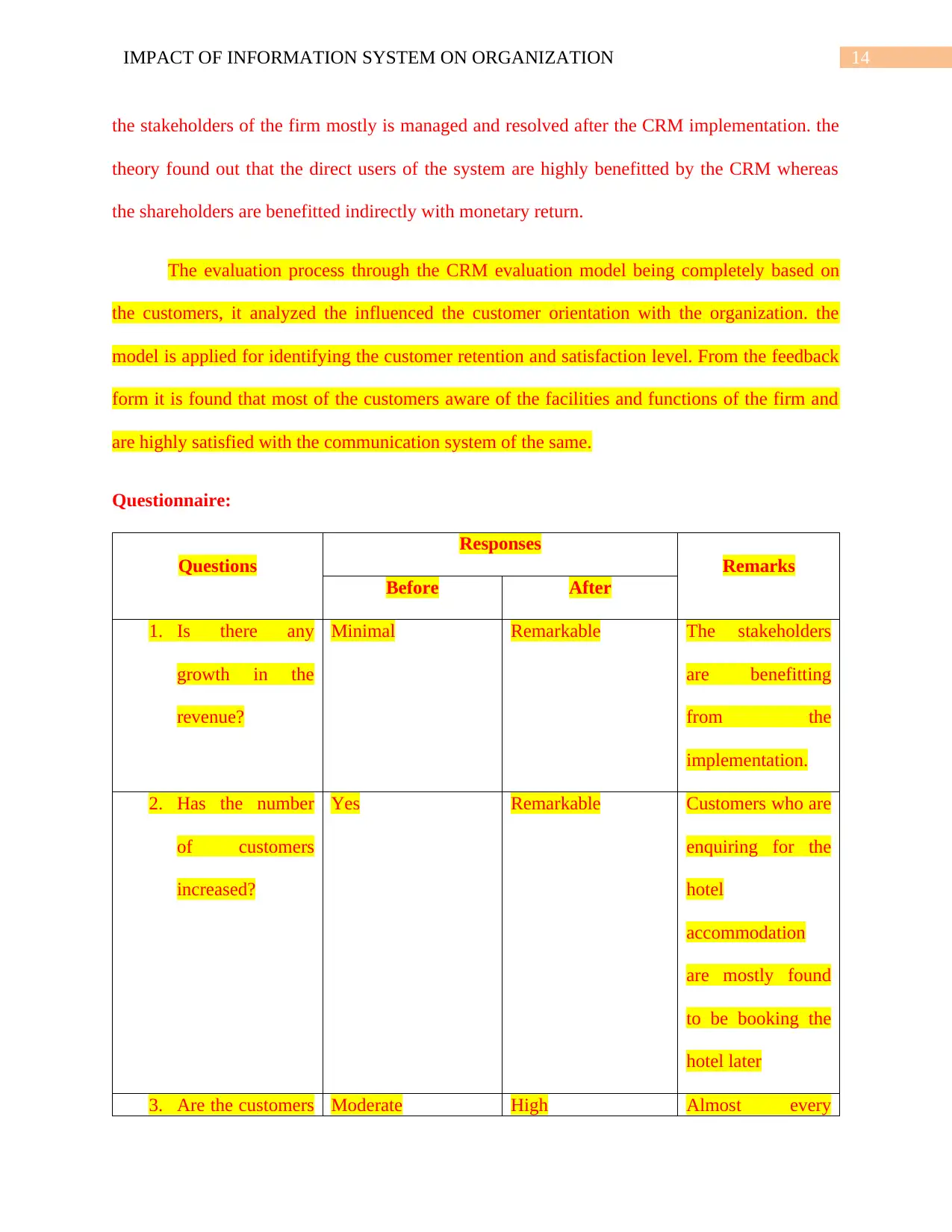
14IMPACT OF INFORMATION SYSTEM ON ORGANIZATION
the stakeholders of the firm mostly is managed and resolved after the CRM implementation. the
theory found out that the direct users of the system are highly benefitted by the CRM whereas
the shareholders are benefitted indirectly with monetary return.
The evaluation process through the CRM evaluation model being completely based on
the customers, it analyzed the influenced the customer orientation with the organization. the
model is applied for identifying the customer retention and satisfaction level. From the feedback
form it is found that most of the customers aware of the facilities and functions of the firm and
are highly satisfied with the communication system of the same.
Questionnaire:
Questions
Responses
Remarks
Before After
1. Is there any
growth in the
revenue?
Minimal Remarkable The stakeholders
are benefitting
from the
implementation.
2. Has the number
of customers
increased?
Yes Remarkable Customers who are
enquiring for the
hotel
accommodation
are mostly found
to be booking the
hotel later
3. Are the customers Moderate High Almost every
the stakeholders of the firm mostly is managed and resolved after the CRM implementation. the
theory found out that the direct users of the system are highly benefitted by the CRM whereas
the shareholders are benefitted indirectly with monetary return.
The evaluation process through the CRM evaluation model being completely based on
the customers, it analyzed the influenced the customer orientation with the organization. the
model is applied for identifying the customer retention and satisfaction level. From the feedback
form it is found that most of the customers aware of the facilities and functions of the firm and
are highly satisfied with the communication system of the same.
Questionnaire:
Questions
Responses
Remarks
Before After
1. Is there any
growth in the
revenue?
Minimal Remarkable The stakeholders
are benefitting
from the
implementation.
2. Has the number
of customers
increased?
Yes Remarkable Customers who are
enquiring for the
hotel
accommodation
are mostly found
to be booking the
hotel later
3. Are the customers Moderate High Almost every
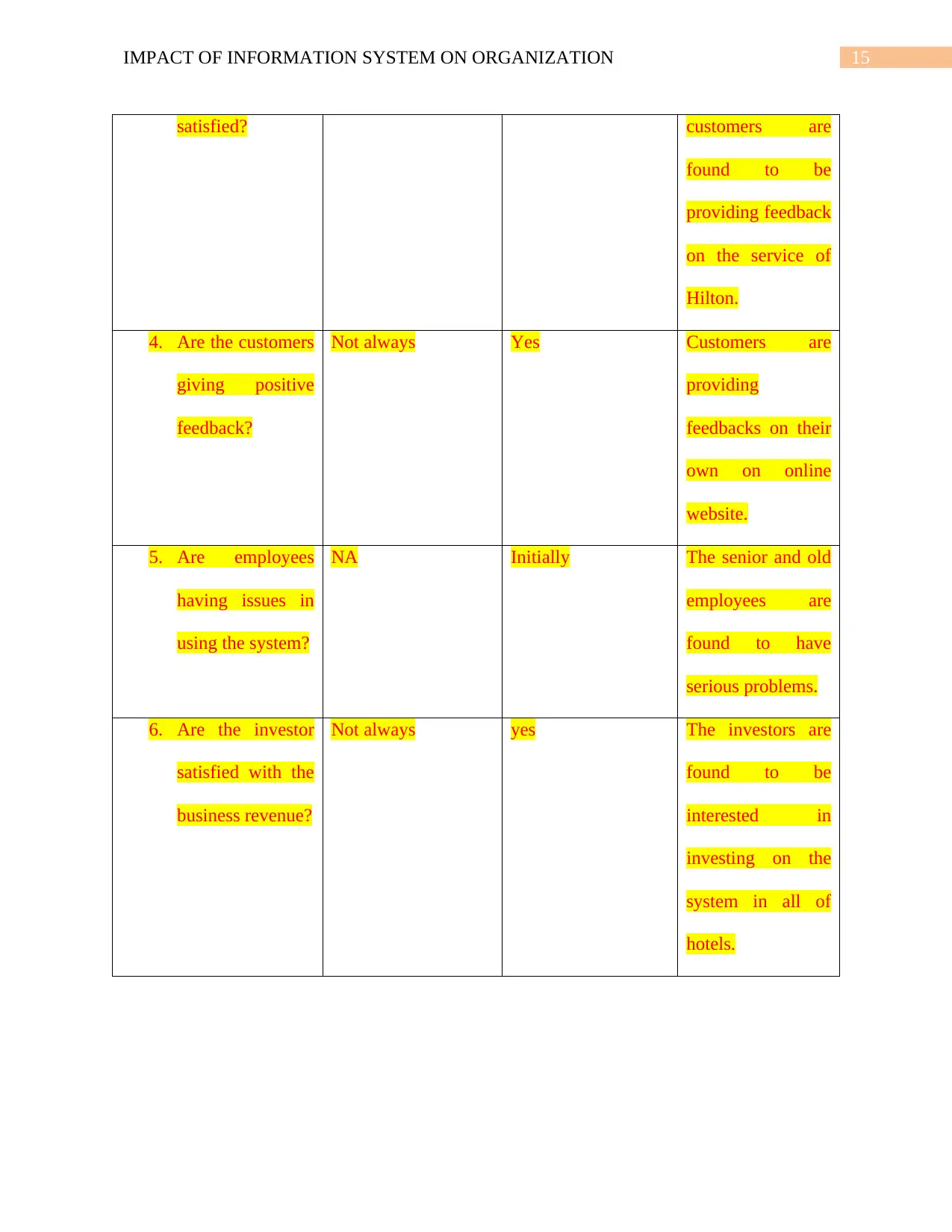
15IMPACT OF INFORMATION SYSTEM ON ORGANIZATION
satisfied? customers are
found to be
providing feedback
on the service of
Hilton.
4. Are the customers
giving positive
feedback?
Not always Yes Customers are
providing
feedbacks on their
own on online
website.
5. Are employees
having issues in
using the system?
NA Initially The senior and old
employees are
found to have
serious problems.
6. Are the investor
satisfied with the
business revenue?
Not always yes The investors are
found to be
interested in
investing on the
system in all of
hotels.
satisfied? customers are
found to be
providing feedback
on the service of
Hilton.
4. Are the customers
giving positive
feedback?
Not always Yes Customers are
providing
feedbacks on their
own on online
website.
5. Are employees
having issues in
using the system?
NA Initially The senior and old
employees are
found to have
serious problems.
6. Are the investor
satisfied with the
business revenue?
Not always yes The investors are
found to be
interested in
investing on the
system in all of
hotels.
Secure Best Marks with AI Grader
Need help grading? Try our AI Grader for instant feedback on your assignments.
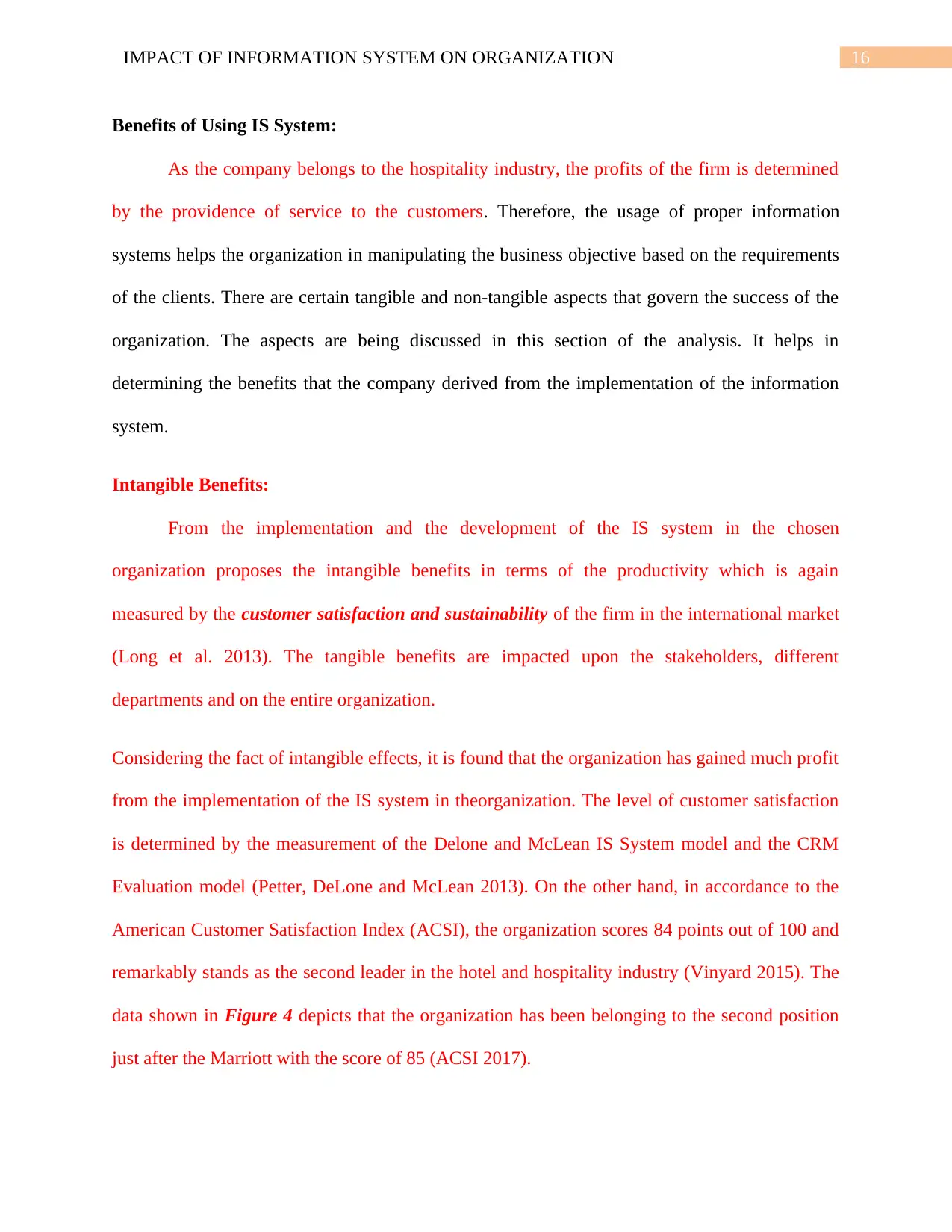
16IMPACT OF INFORMATION SYSTEM ON ORGANIZATION
Benefits of Using IS System:
As the company belongs to the hospitality industry, the profits of the firm is determined
by the providence of service to the customers. Therefore, the usage of proper information
systems helps the organization in manipulating the business objective based on the requirements
of the clients. There are certain tangible and non-tangible aspects that govern the success of the
organization. The aspects are being discussed in this section of the analysis. It helps in
determining the benefits that the company derived from the implementation of the information
system.
Intangible Benefits:
From the implementation and the development of the IS system in the chosen
organization proposes the intangible benefits in terms of the productivity which is again
measured by the customer satisfaction and sustainability of the firm in the international market
(Long et al. 2013). The tangible benefits are impacted upon the stakeholders, different
departments and on the entire organization.
Considering the fact of intangible effects, it is found that the organization has gained much profit
from the implementation of the IS system in theorganization. The level of customer satisfaction
is determined by the measurement of the Delone and McLean IS System model and the CRM
Evaluation model (Petter, DeLone and McLean 2013). On the other hand, in accordance to the
American Customer Satisfaction Index (ACSI), the organization scores 84 points out of 100 and
remarkably stands as the second leader in the hotel and hospitality industry (Vinyard 2015). The
data shown in Figure 4 depicts that the organization has been belonging to the second position
just after the Marriott with the score of 85 (ACSI 2017).
Benefits of Using IS System:
As the company belongs to the hospitality industry, the profits of the firm is determined
by the providence of service to the customers. Therefore, the usage of proper information
systems helps the organization in manipulating the business objective based on the requirements
of the clients. There are certain tangible and non-tangible aspects that govern the success of the
organization. The aspects are being discussed in this section of the analysis. It helps in
determining the benefits that the company derived from the implementation of the information
system.
Intangible Benefits:
From the implementation and the development of the IS system in the chosen
organization proposes the intangible benefits in terms of the productivity which is again
measured by the customer satisfaction and sustainability of the firm in the international market
(Long et al. 2013). The tangible benefits are impacted upon the stakeholders, different
departments and on the entire organization.
Considering the fact of intangible effects, it is found that the organization has gained much profit
from the implementation of the IS system in theorganization. The level of customer satisfaction
is determined by the measurement of the Delone and McLean IS System model and the CRM
Evaluation model (Petter, DeLone and McLean 2013). On the other hand, in accordance to the
American Customer Satisfaction Index (ACSI), the organization scores 84 points out of 100 and
remarkably stands as the second leader in the hotel and hospitality industry (Vinyard 2015). The
data shown in Figure 4 depicts that the organization has been belonging to the second position
just after the Marriott with the score of 85 (ACSI 2017).
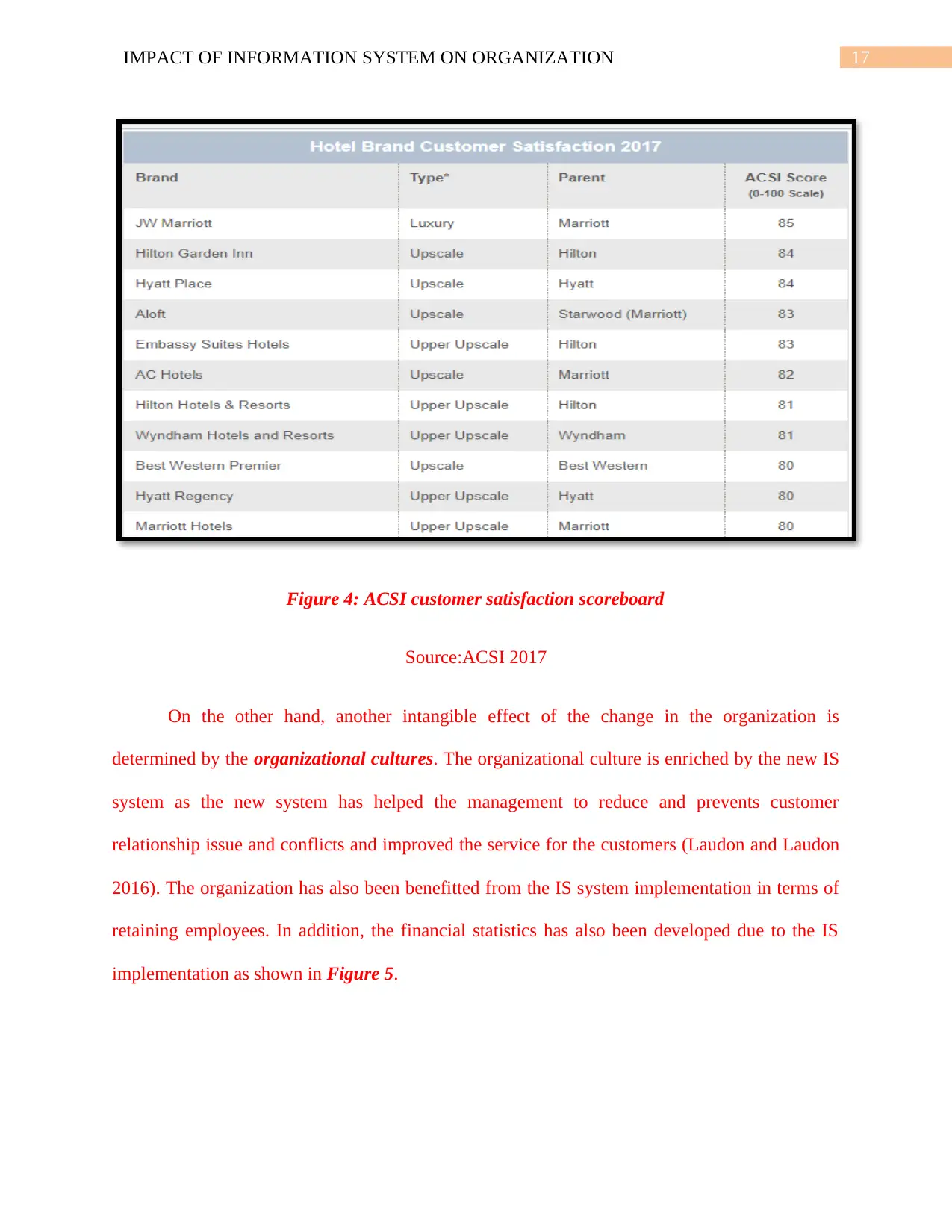
17IMPACT OF INFORMATION SYSTEM ON ORGANIZATION
Figure 4: ACSI customer satisfaction scoreboard
Source:ACSI 2017
On the other hand, another intangible effect of the change in the organization is
determined by the organizational cultures. The organizational culture is enriched by the new IS
system as the new system has helped the management to reduce and prevents customer
relationship issue and conflicts and improved the service for the customers (Laudon and Laudon
2016). The organization has also been benefitted from the IS system implementation in terms of
retaining employees. In addition, the financial statistics has also been developed due to the IS
implementation as shown in Figure 5.
Figure 4: ACSI customer satisfaction scoreboard
Source:ACSI 2017
On the other hand, another intangible effect of the change in the organization is
determined by the organizational cultures. The organizational culture is enriched by the new IS
system as the new system has helped the management to reduce and prevents customer
relationship issue and conflicts and improved the service for the customers (Laudon and Laudon
2016). The organization has also been benefitted from the IS system implementation in terms of
retaining employees. In addition, the financial statistics has also been developed due to the IS
implementation as shown in Figure 5.
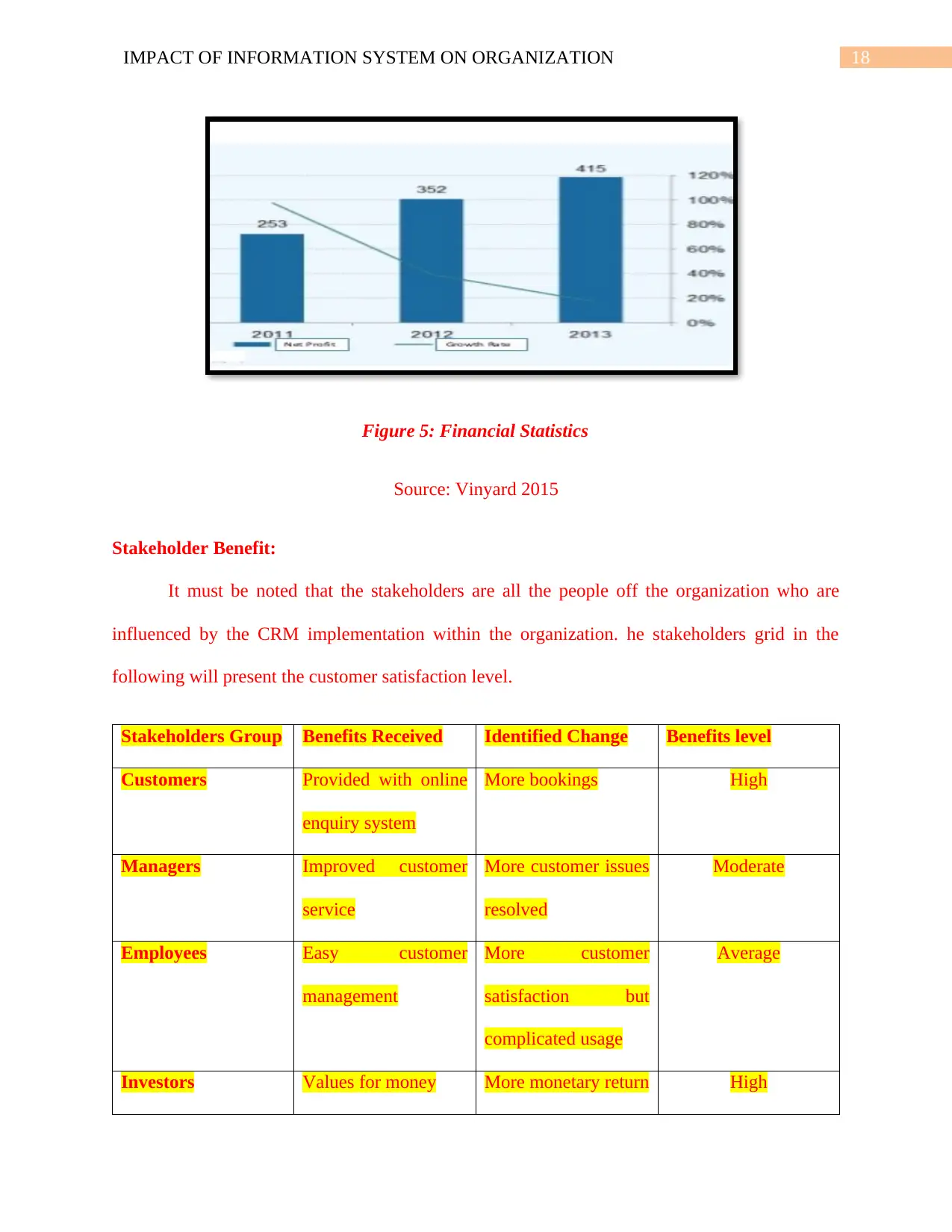
18IMPACT OF INFORMATION SYSTEM ON ORGANIZATION
Figure 5: Financial Statistics
Source: Vinyard 2015
Stakeholder Benefit:
It must be noted that the stakeholders are all the people off the organization who are
influenced by the CRM implementation within the organization. he stakeholders grid in the
following will present the customer satisfaction level.
Stakeholders Group Benefits Received Identified Change Benefits level
Customers Provided with online
enquiry system
More bookings High
Managers Improved customer
service
More customer issues
resolved
Moderate
Employees Easy customer
management
More customer
satisfaction but
complicated usage
Average
Investors Values for money More monetary return High
Figure 5: Financial Statistics
Source: Vinyard 2015
Stakeholder Benefit:
It must be noted that the stakeholders are all the people off the organization who are
influenced by the CRM implementation within the organization. he stakeholders grid in the
following will present the customer satisfaction level.
Stakeholders Group Benefits Received Identified Change Benefits level
Customers Provided with online
enquiry system
More bookings High
Managers Improved customer
service
More customer issues
resolved
Moderate
Employees Easy customer
management
More customer
satisfaction but
complicated usage
Average
Investors Values for money More monetary return High
Paraphrase This Document
Need a fresh take? Get an instant paraphrase of this document with our AI Paraphraser
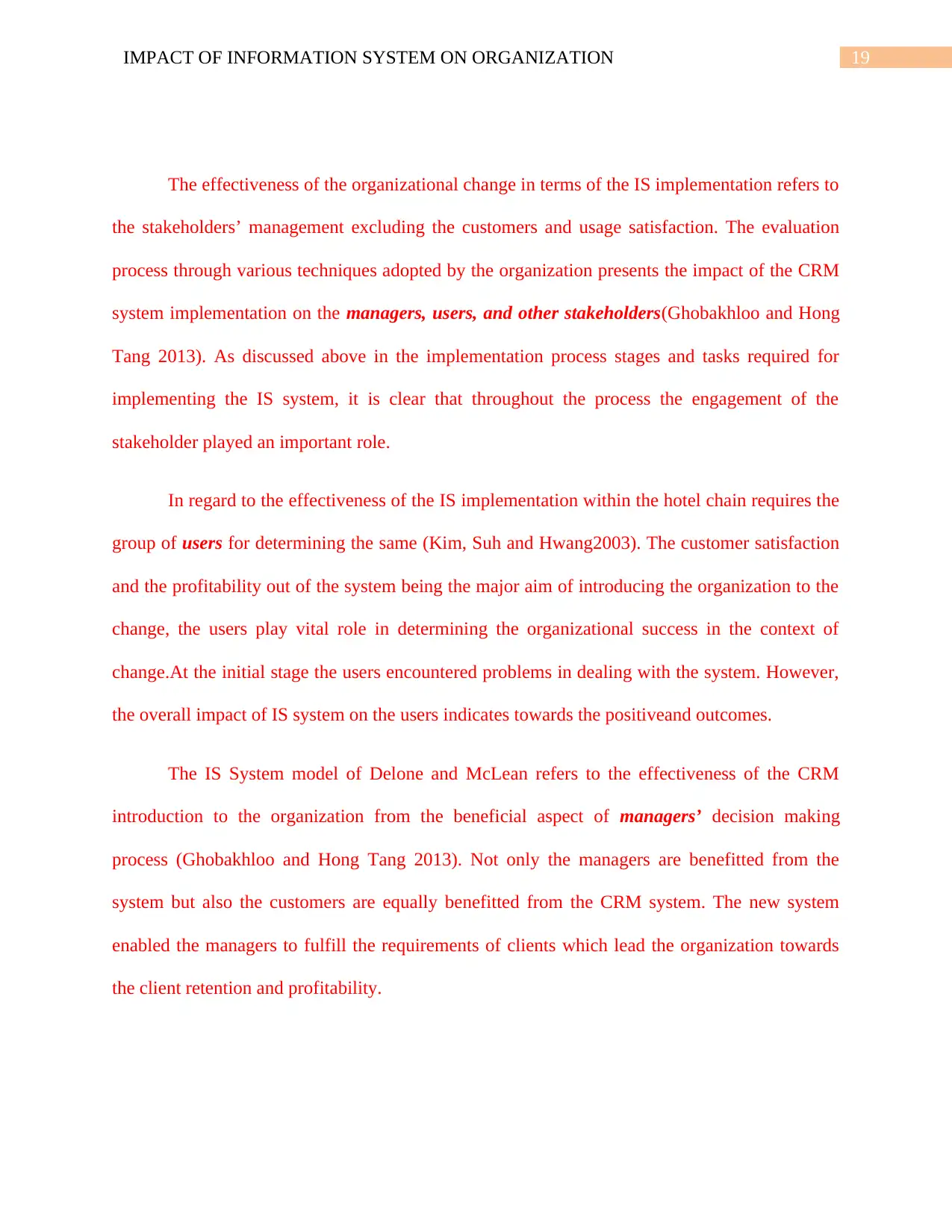
19IMPACT OF INFORMATION SYSTEM ON ORGANIZATION
The effectiveness of the organizational change in terms of the IS implementation refers to
the stakeholders’ management excluding the customers and usage satisfaction. The evaluation
process through various techniques adopted by the organization presents the impact of the CRM
system implementation on the managers, users, and other stakeholders(Ghobakhloo and Hong
Tang 2013). As discussed above in the implementation process stages and tasks required for
implementing the IS system, it is clear that throughout the process the engagement of the
stakeholder played an important role.
In regard to the effectiveness of the IS implementation within the hotel chain requires the
group of users for determining the same (Kim, Suh and Hwang2003). The customer satisfaction
and the profitability out of the system being the major aim of introducing the organization to the
change, the users play vital role in determining the organizational success in the context of
change.At the initial stage the users encountered problems in dealing with the system. However,
the overall impact of IS system on the users indicates towards the positiveand outcomes.
The IS System model of Delone and McLean refers to the effectiveness of the CRM
introduction to the organization from the beneficial aspect of managers’ decision making
process (Ghobakhloo and Hong Tang 2013). Not only the managers are benefitted from the
system but also the customers are equally benefitted from the CRM system. The new system
enabled the managers to fulfill the requirements of clients which lead the organization towards
the client retention and profitability.
The effectiveness of the organizational change in terms of the IS implementation refers to
the stakeholders’ management excluding the customers and usage satisfaction. The evaluation
process through various techniques adopted by the organization presents the impact of the CRM
system implementation on the managers, users, and other stakeholders(Ghobakhloo and Hong
Tang 2013). As discussed above in the implementation process stages and tasks required for
implementing the IS system, it is clear that throughout the process the engagement of the
stakeholder played an important role.
In regard to the effectiveness of the IS implementation within the hotel chain requires the
group of users for determining the same (Kim, Suh and Hwang2003). The customer satisfaction
and the profitability out of the system being the major aim of introducing the organization to the
change, the users play vital role in determining the organizational success in the context of
change.At the initial stage the users encountered problems in dealing with the system. However,
the overall impact of IS system on the users indicates towards the positiveand outcomes.
The IS System model of Delone and McLean refers to the effectiveness of the CRM
introduction to the organization from the beneficial aspect of managers’ decision making
process (Ghobakhloo and Hong Tang 2013). Not only the managers are benefitted from the
system but also the customers are equally benefitted from the CRM system. The new system
enabled the managers to fulfill the requirements of clients which lead the organization towards
the client retention and profitability.
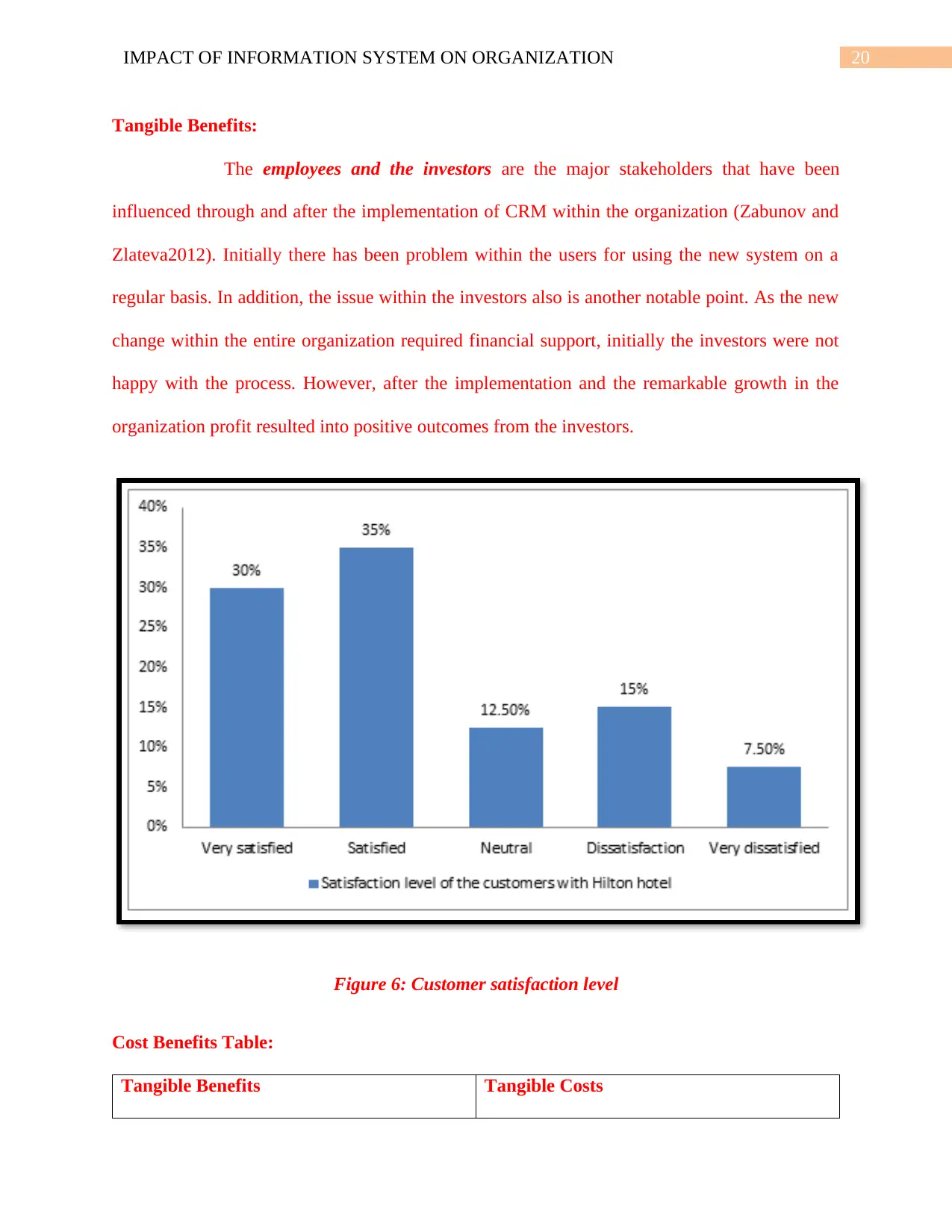
20IMPACT OF INFORMATION SYSTEM ON ORGANIZATION
Tangible Benefits:
The employees and the investors are the major stakeholders that have been
influenced through and after the implementation of CRM within the organization (Zabunov and
Zlateva2012). Initially there has been problem within the users for using the new system on a
regular basis. In addition, the issue within the investors also is another notable point. As the new
change within the entire organization required financial support, initially the investors were not
happy with the process. However, after the implementation and the remarkable growth in the
organization profit resulted into positive outcomes from the investors.
Figure 6: Customer satisfaction level
Cost Benefits Table:
Tangible Benefits Tangible Costs
Tangible Benefits:
The employees and the investors are the major stakeholders that have been
influenced through and after the implementation of CRM within the organization (Zabunov and
Zlateva2012). Initially there has been problem within the users for using the new system on a
regular basis. In addition, the issue within the investors also is another notable point. As the new
change within the entire organization required financial support, initially the investors were not
happy with the process. However, after the implementation and the remarkable growth in the
organization profit resulted into positive outcomes from the investors.
Figure 6: Customer satisfaction level
Cost Benefits Table:
Tangible Benefits Tangible Costs
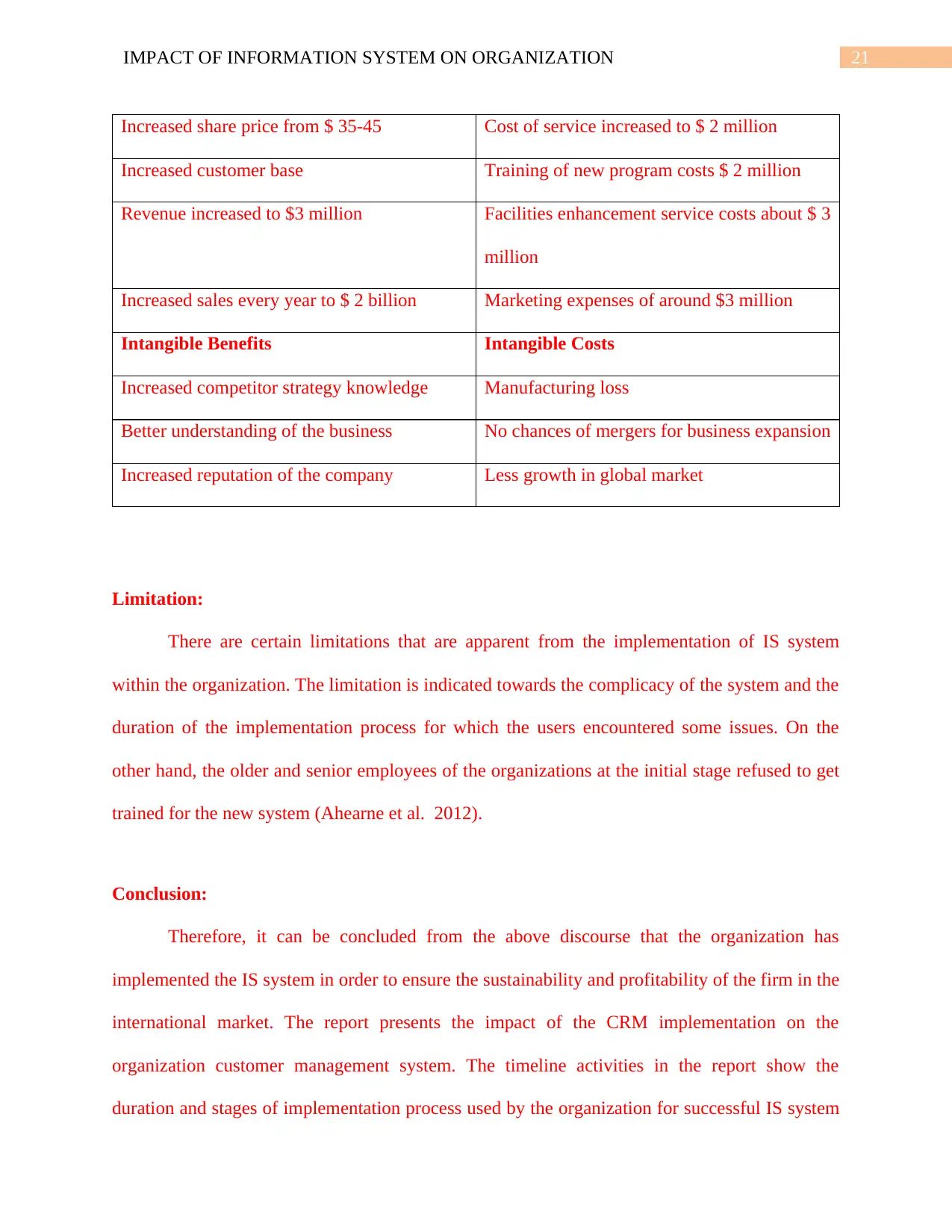
21IMPACT OF INFORMATION SYSTEM ON ORGANIZATION
Increased share price from $ 35-45 Cost of service increased to $ 2 million
Increased customer base Training of new program costs $ 2 million
Revenue increased to $3 million Facilities enhancement service costs about $ 3
million
Increased sales every year to $ 2 billion Marketing expenses of around $3 million
Intangible Benefits Intangible Costs
Increased competitor strategy knowledge Manufacturing loss
Better understanding of the business No chances of mergers for business expansion
Increased reputation of the company Less growth in global market
Limitation:
There are certain limitations that are apparent from the implementation of IS system
within the organization. The limitation is indicated towards the complicacy of the system and the
duration of the implementation process for which the users encountered some issues. On the
other hand, the older and senior employees of the organizations at the initial stage refused to get
trained for the new system (Ahearne et al. 2012).
Conclusion:
Therefore, it can be concluded from the above discourse that the organization has
implemented the IS system in order to ensure the sustainability and profitability of the firm in the
international market. The report presents the impact of the CRM implementation on the
organization customer management system. The timeline activities in the report show the
duration and stages of implementation process used by the organization for successful IS system
Increased share price from $ 35-45 Cost of service increased to $ 2 million
Increased customer base Training of new program costs $ 2 million
Revenue increased to $3 million Facilities enhancement service costs about $ 3
million
Increased sales every year to $ 2 billion Marketing expenses of around $3 million
Intangible Benefits Intangible Costs
Increased competitor strategy knowledge Manufacturing loss
Better understanding of the business No chances of mergers for business expansion
Increased reputation of the company Less growth in global market
Limitation:
There are certain limitations that are apparent from the implementation of IS system
within the organization. The limitation is indicated towards the complicacy of the system and the
duration of the implementation process for which the users encountered some issues. On the
other hand, the older and senior employees of the organizations at the initial stage refused to get
trained for the new system (Ahearne et al. 2012).
Conclusion:
Therefore, it can be concluded from the above discourse that the organization has
implemented the IS system in order to ensure the sustainability and profitability of the firm in the
international market. The report presents the impact of the CRM implementation on the
organization customer management system. The timeline activities in the report show the
duration and stages of implementation process used by the organization for successful IS system
Secure Best Marks with AI Grader
Need help grading? Try our AI Grader for instant feedback on your assignments.
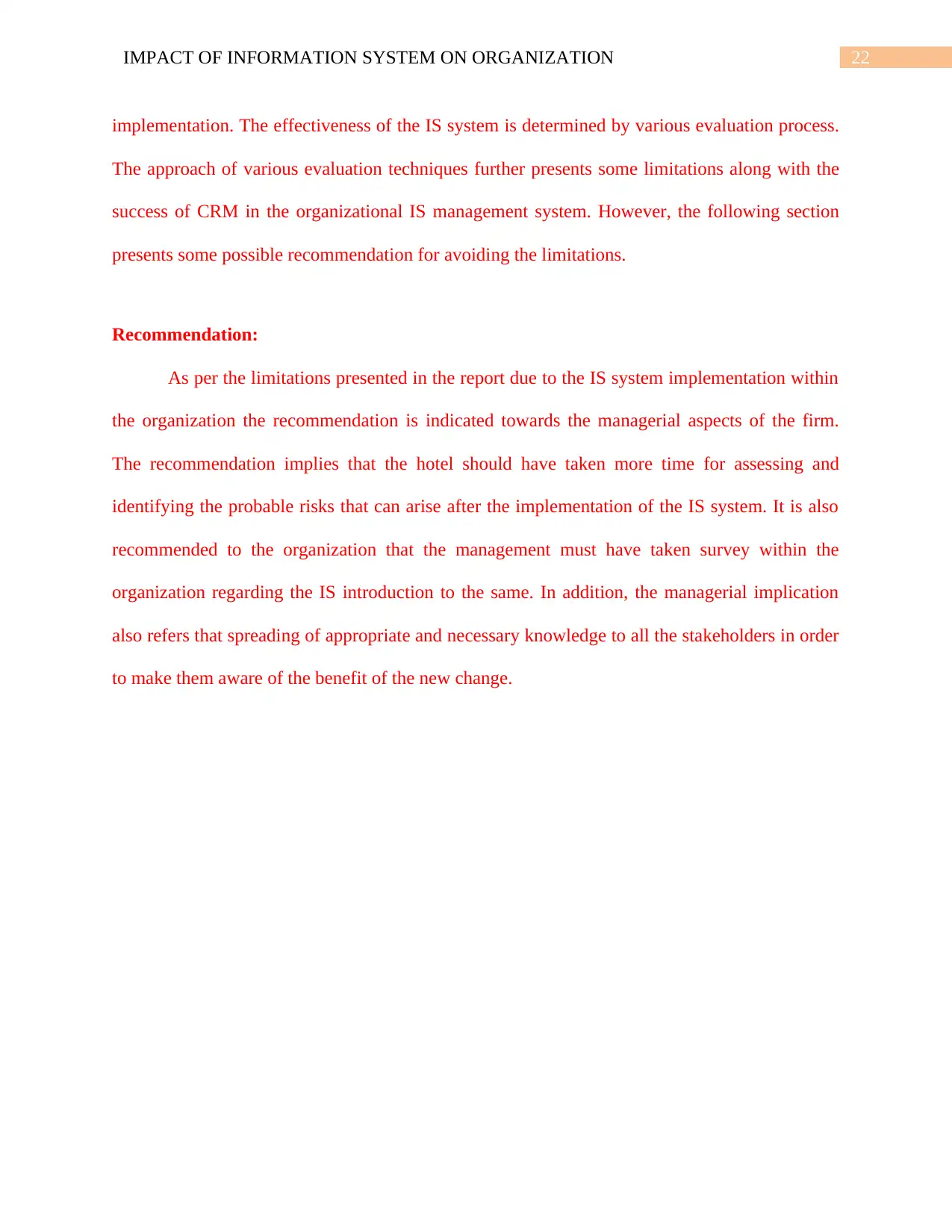
22IMPACT OF INFORMATION SYSTEM ON ORGANIZATION
implementation. The effectiveness of the IS system is determined by various evaluation process.
The approach of various evaluation techniques further presents some limitations along with the
success of CRM in the organizational IS management system. However, the following section
presents some possible recommendation for avoiding the limitations.
Recommendation:
As per the limitations presented in the report due to the IS system implementation within
the organization the recommendation is indicated towards the managerial aspects of the firm.
The recommendation implies that the hotel should have taken more time for assessing and
identifying the probable risks that can arise after the implementation of the IS system. It is also
recommended to the organization that the management must have taken survey within the
organization regarding the IS introduction to the same. In addition, the managerial implication
also refers that spreading of appropriate and necessary knowledge to all the stakeholders in order
to make them aware of the benefit of the new change.
implementation. The effectiveness of the IS system is determined by various evaluation process.
The approach of various evaluation techniques further presents some limitations along with the
success of CRM in the organizational IS management system. However, the following section
presents some possible recommendation for avoiding the limitations.
Recommendation:
As per the limitations presented in the report due to the IS system implementation within
the organization the recommendation is indicated towards the managerial aspects of the firm.
The recommendation implies that the hotel should have taken more time for assessing and
identifying the probable risks that can arise after the implementation of the IS system. It is also
recommended to the organization that the management must have taken survey within the
organization regarding the IS introduction to the same. In addition, the managerial implication
also refers that spreading of appropriate and necessary knowledge to all the stakeholders in order
to make them aware of the benefit of the new change.
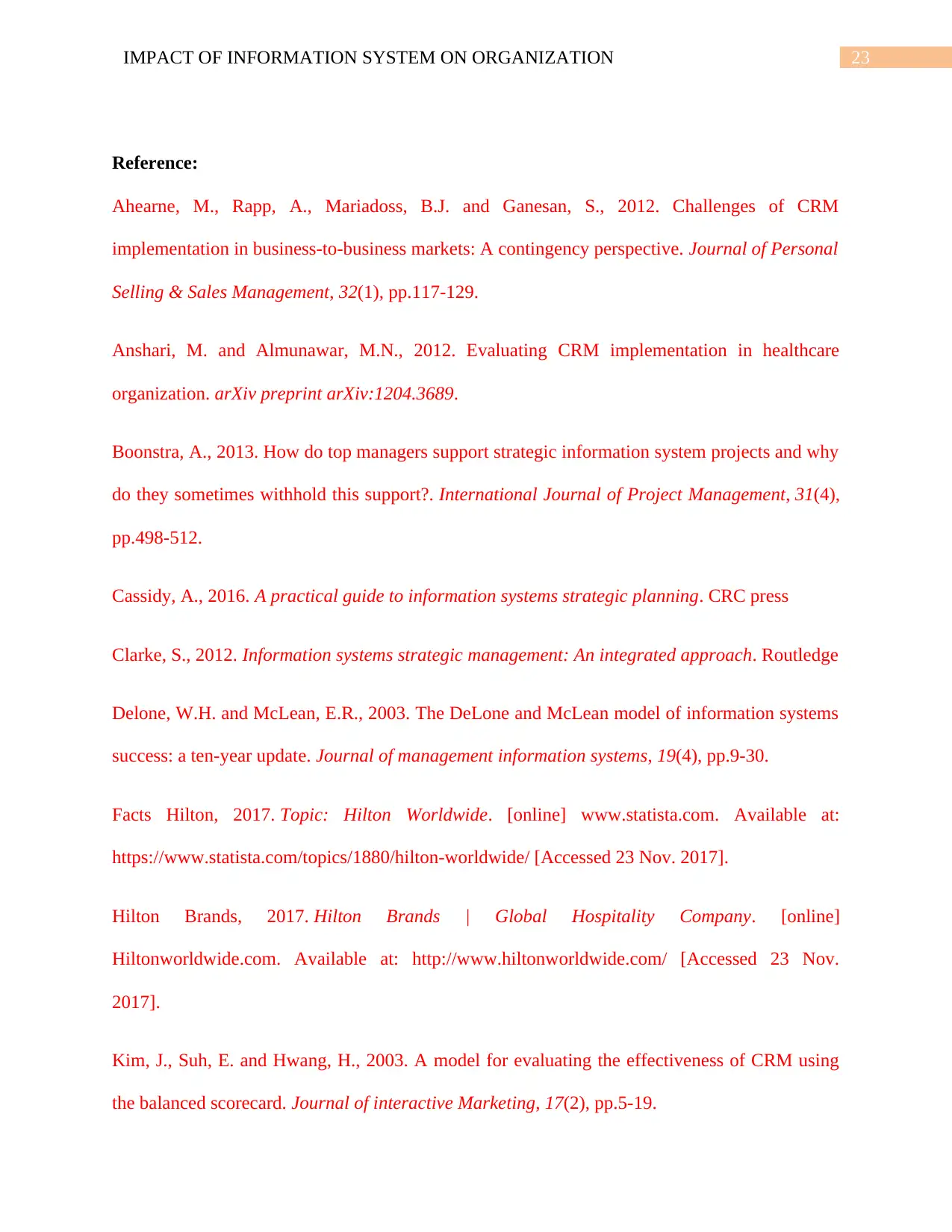
23IMPACT OF INFORMATION SYSTEM ON ORGANIZATION
Reference:
Ahearne, M., Rapp, A., Mariadoss, B.J. and Ganesan, S., 2012. Challenges of CRM
implementation in business-to-business markets: A contingency perspective. Journal of Personal
Selling & Sales Management, 32(1), pp.117-129.
Anshari, M. and Almunawar, M.N., 2012. Evaluating CRM implementation in healthcare
organization. arXiv preprint arXiv:1204.3689.
Boonstra, A., 2013. How do top managers support strategic information system projects and why
do they sometimes withhold this support?. International Journal of Project Management, 31(4),
pp.498-512.
Cassidy, A., 2016. A practical guide to information systems strategic planning. CRC press
Clarke, S., 2012. Information systems strategic management: An integrated approach. Routledge
Delone, W.H. and McLean, E.R., 2003. The DeLone and McLean model of information systems
success: a ten-year update. Journal of management information systems, 19(4), pp.9-30.
Facts Hilton, 2017. Topic: Hilton Worldwide. [online] www.statista.com. Available at:
https://www.statista.com/topics/1880/hilton-worldwide/ [Accessed 23 Nov. 2017].
Hilton Brands, 2017. Hilton Brands | Global Hospitality Company. [online]
Hiltonworldwide.com. Available at: http://www.hiltonworldwide.com/ [Accessed 23 Nov.
2017].
Kim, J., Suh, E. and Hwang, H., 2003. A model for evaluating the effectiveness of CRM using
the balanced scorecard. Journal of interactive Marketing, 17(2), pp.5-19.
Reference:
Ahearne, M., Rapp, A., Mariadoss, B.J. and Ganesan, S., 2012. Challenges of CRM
implementation in business-to-business markets: A contingency perspective. Journal of Personal
Selling & Sales Management, 32(1), pp.117-129.
Anshari, M. and Almunawar, M.N., 2012. Evaluating CRM implementation in healthcare
organization. arXiv preprint arXiv:1204.3689.
Boonstra, A., 2013. How do top managers support strategic information system projects and why
do they sometimes withhold this support?. International Journal of Project Management, 31(4),
pp.498-512.
Cassidy, A., 2016. A practical guide to information systems strategic planning. CRC press
Clarke, S., 2012. Information systems strategic management: An integrated approach. Routledge
Delone, W.H. and McLean, E.R., 2003. The DeLone and McLean model of information systems
success: a ten-year update. Journal of management information systems, 19(4), pp.9-30.
Facts Hilton, 2017. Topic: Hilton Worldwide. [online] www.statista.com. Available at:
https://www.statista.com/topics/1880/hilton-worldwide/ [Accessed 23 Nov. 2017].
Hilton Brands, 2017. Hilton Brands | Global Hospitality Company. [online]
Hiltonworldwide.com. Available at: http://www.hiltonworldwide.com/ [Accessed 23 Nov.
2017].
Kim, J., Suh, E. and Hwang, H., 2003. A model for evaluating the effectiveness of CRM using
the balanced scorecard. Journal of interactive Marketing, 17(2), pp.5-19.
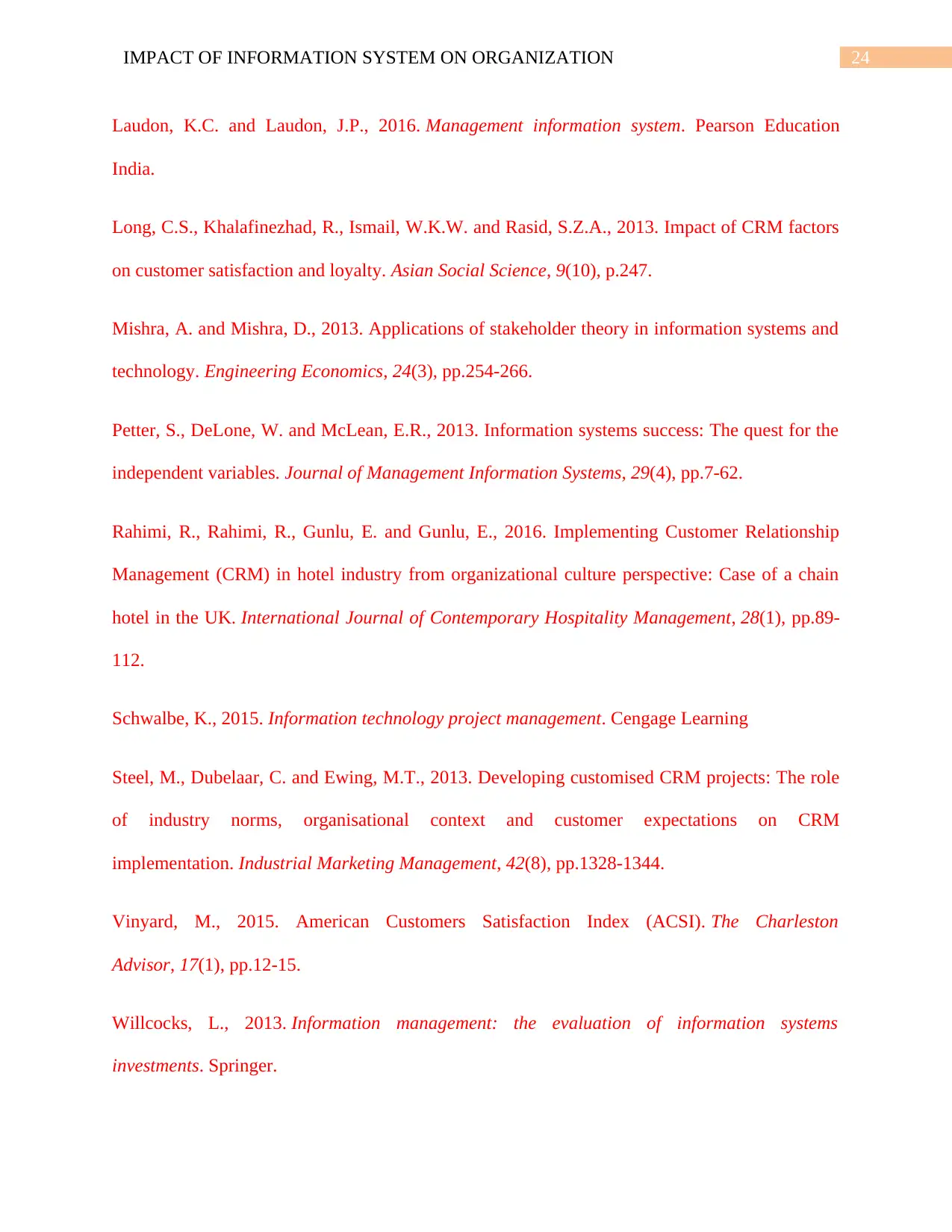
24IMPACT OF INFORMATION SYSTEM ON ORGANIZATION
Laudon, K.C. and Laudon, J.P., 2016. Management information system. Pearson Education
India.
Long, C.S., Khalafinezhad, R., Ismail, W.K.W. and Rasid, S.Z.A., 2013. Impact of CRM factors
on customer satisfaction and loyalty. Asian Social Science, 9(10), p.247.
Mishra, A. and Mishra, D., 2013. Applications of stakeholder theory in information systems and
technology. Engineering Economics, 24(3), pp.254-266.
Petter, S., DeLone, W. and McLean, E.R., 2013. Information systems success: The quest for the
independent variables. Journal of Management Information Systems, 29(4), pp.7-62.
Rahimi, R., Rahimi, R., Gunlu, E. and Gunlu, E., 2016. Implementing Customer Relationship
Management (CRM) in hotel industry from organizational culture perspective: Case of a chain
hotel in the UK. International Journal of Contemporary Hospitality Management, 28(1), pp.89-
112.
Schwalbe, K., 2015. Information technology project management. Cengage Learning
Steel, M., Dubelaar, C. and Ewing, M.T., 2013. Developing customised CRM projects: The role
of industry norms, organisational context and customer expectations on CRM
implementation. Industrial Marketing Management, 42(8), pp.1328-1344.
Vinyard, M., 2015. American Customers Satisfaction Index (ACSI). The Charleston
Advisor, 17(1), pp.12-15.
Willcocks, L., 2013. Information management: the evaluation of information systems
investments. Springer.
Laudon, K.C. and Laudon, J.P., 2016. Management information system. Pearson Education
India.
Long, C.S., Khalafinezhad, R., Ismail, W.K.W. and Rasid, S.Z.A., 2013. Impact of CRM factors
on customer satisfaction and loyalty. Asian Social Science, 9(10), p.247.
Mishra, A. and Mishra, D., 2013. Applications of stakeholder theory in information systems and
technology. Engineering Economics, 24(3), pp.254-266.
Petter, S., DeLone, W. and McLean, E.R., 2013. Information systems success: The quest for the
independent variables. Journal of Management Information Systems, 29(4), pp.7-62.
Rahimi, R., Rahimi, R., Gunlu, E. and Gunlu, E., 2016. Implementing Customer Relationship
Management (CRM) in hotel industry from organizational culture perspective: Case of a chain
hotel in the UK. International Journal of Contemporary Hospitality Management, 28(1), pp.89-
112.
Schwalbe, K., 2015. Information technology project management. Cengage Learning
Steel, M., Dubelaar, C. and Ewing, M.T., 2013. Developing customised CRM projects: The role
of industry norms, organisational context and customer expectations on CRM
implementation. Industrial Marketing Management, 42(8), pp.1328-1344.
Vinyard, M., 2015. American Customers Satisfaction Index (ACSI). The Charleston
Advisor, 17(1), pp.12-15.
Willcocks, L., 2013. Information management: the evaluation of information systems
investments. Springer.
Paraphrase This Document
Need a fresh take? Get an instant paraphrase of this document with our AI Paraphraser
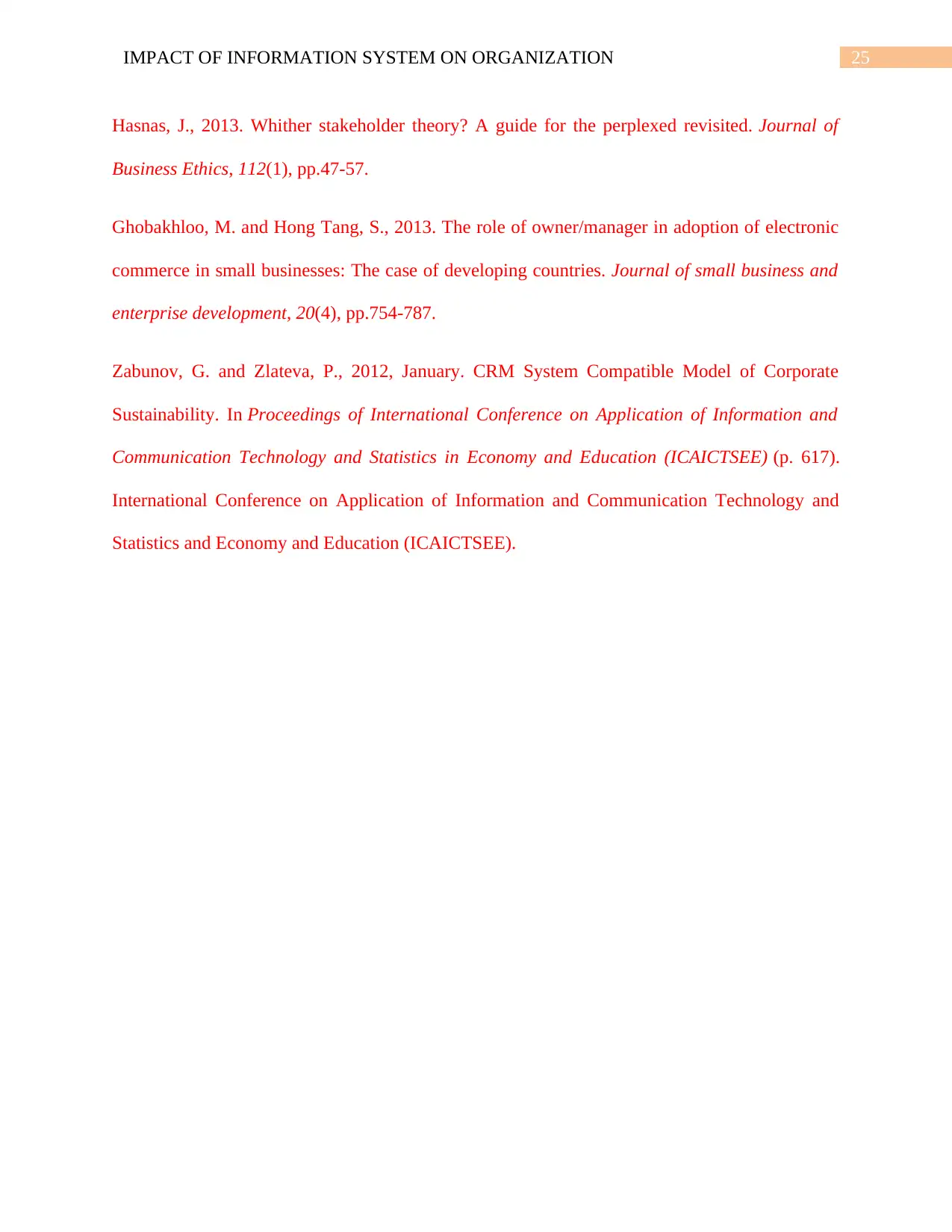
25IMPACT OF INFORMATION SYSTEM ON ORGANIZATION
Hasnas, J., 2013. Whither stakeholder theory? A guide for the perplexed revisited. Journal of
Business Ethics, 112(1), pp.47-57.
Ghobakhloo, M. and Hong Tang, S., 2013. The role of owner/manager in adoption of electronic
commerce in small businesses: The case of developing countries. Journal of small business and
enterprise development, 20(4), pp.754-787.
Zabunov, G. and Zlateva, P., 2012, January. CRM System Compatible Model of Corporate
Sustainability. In Proceedings of International Conference on Application of Information and
Communication Technology and Statistics in Economy and Education (ICAICTSEE) (p. 617).
International Conference on Application of Information and Communication Technology and
Statistics and Economy and Education (ICAICTSEE).
Hasnas, J., 2013. Whither stakeholder theory? A guide for the perplexed revisited. Journal of
Business Ethics, 112(1), pp.47-57.
Ghobakhloo, M. and Hong Tang, S., 2013. The role of owner/manager in adoption of electronic
commerce in small businesses: The case of developing countries. Journal of small business and
enterprise development, 20(4), pp.754-787.
Zabunov, G. and Zlateva, P., 2012, January. CRM System Compatible Model of Corporate
Sustainability. In Proceedings of International Conference on Application of Information and
Communication Technology and Statistics in Economy and Education (ICAICTSEE) (p. 617).
International Conference on Application of Information and Communication Technology and
Statistics and Economy and Education (ICAICTSEE).
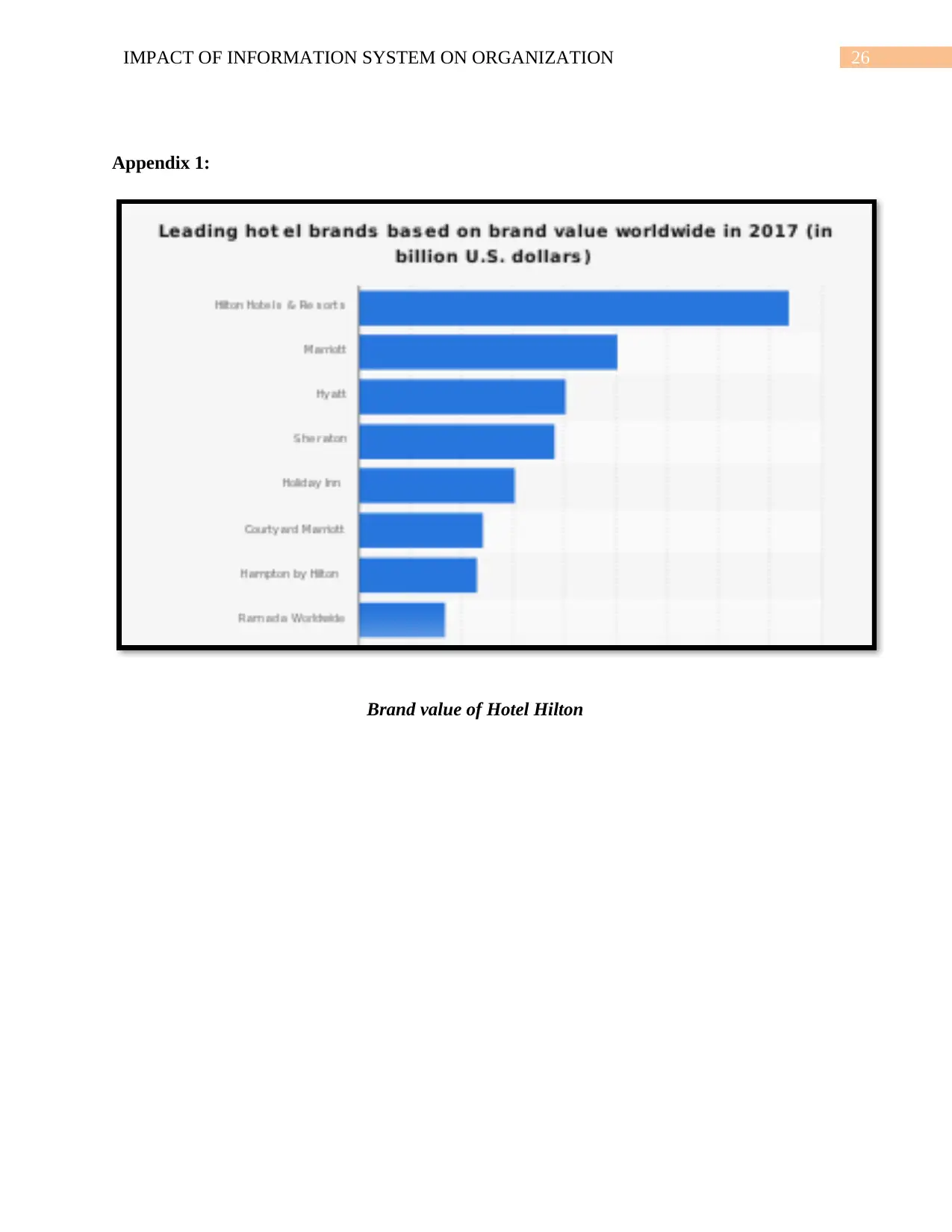
26IMPACT OF INFORMATION SYSTEM ON ORGANIZATION
Appendix 1:
Brand value of Hotel Hilton
Appendix 1:
Brand value of Hotel Hilton
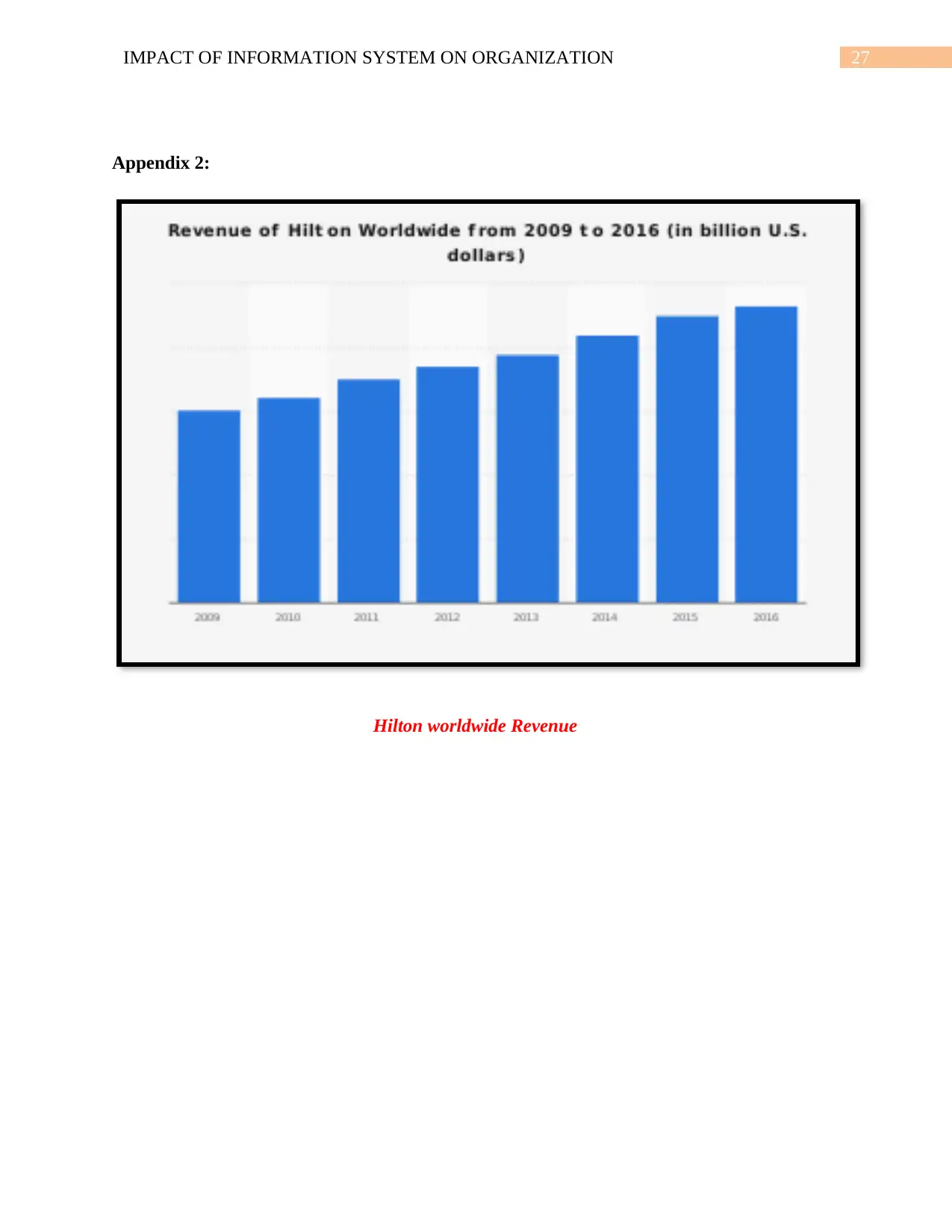
27IMPACT OF INFORMATION SYSTEM ON ORGANIZATION
Appendix 2:
Hilton worldwide Revenue
Appendix 2:
Hilton worldwide Revenue
1 out of 28
Related Documents
Your All-in-One AI-Powered Toolkit for Academic Success.
+13062052269
info@desklib.com
Available 24*7 on WhatsApp / Email
![[object Object]](/_next/static/media/star-bottom.7253800d.svg)
Unlock your academic potential
© 2024 | Zucol Services PVT LTD | All rights reserved.





